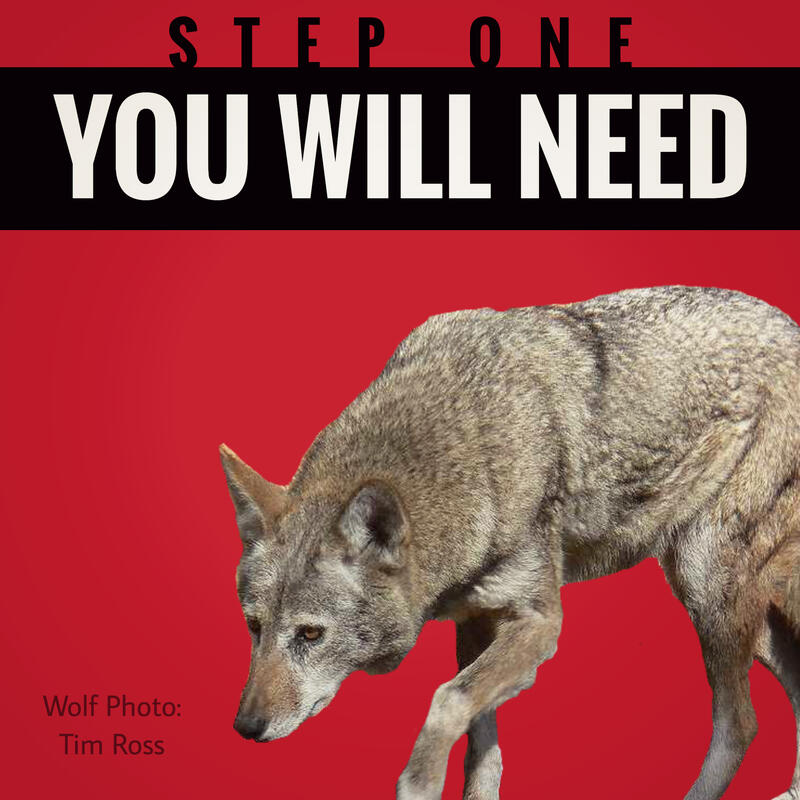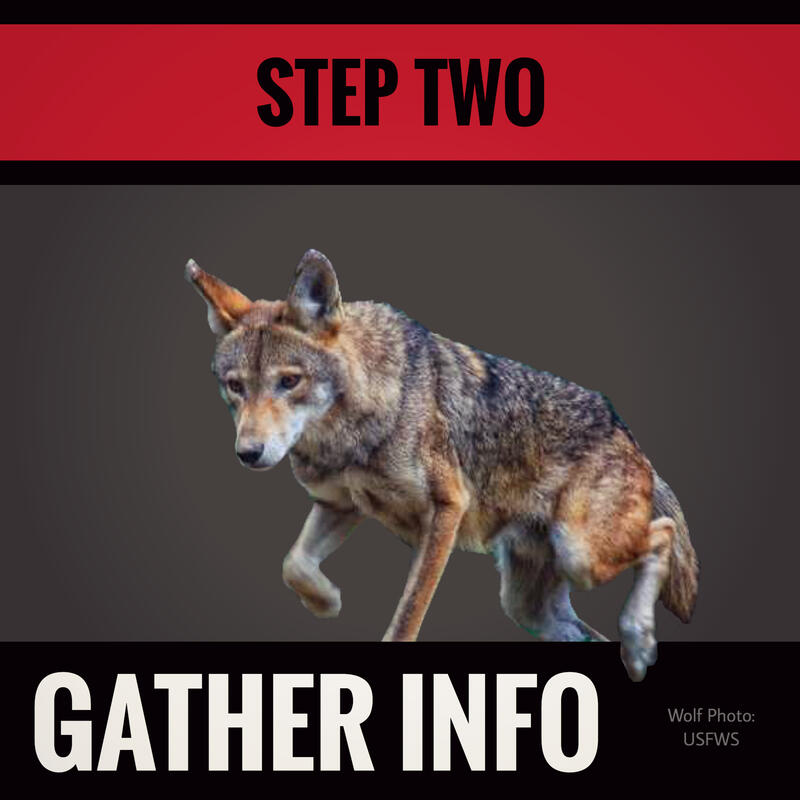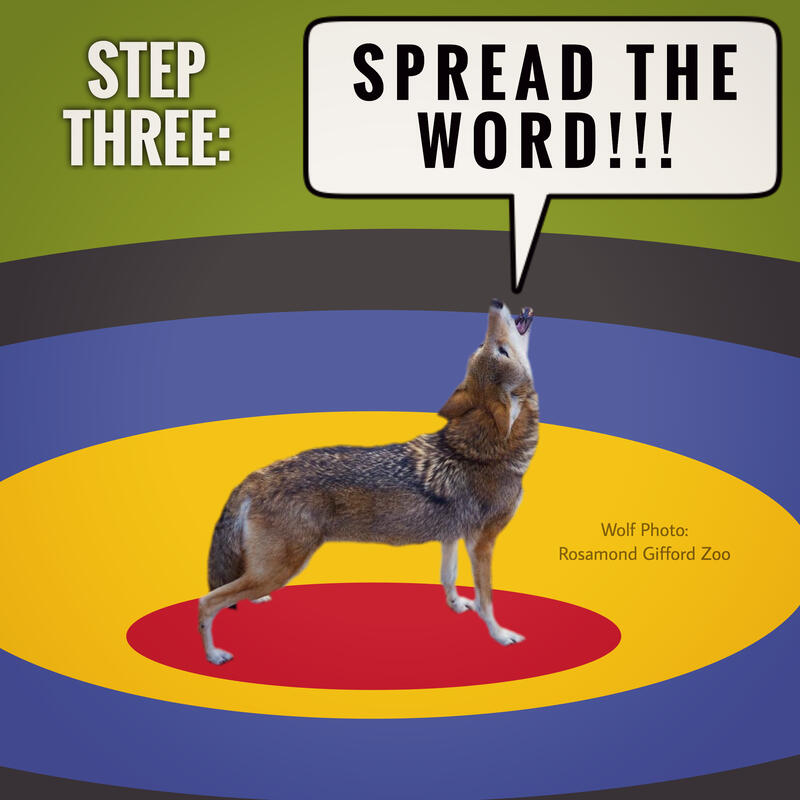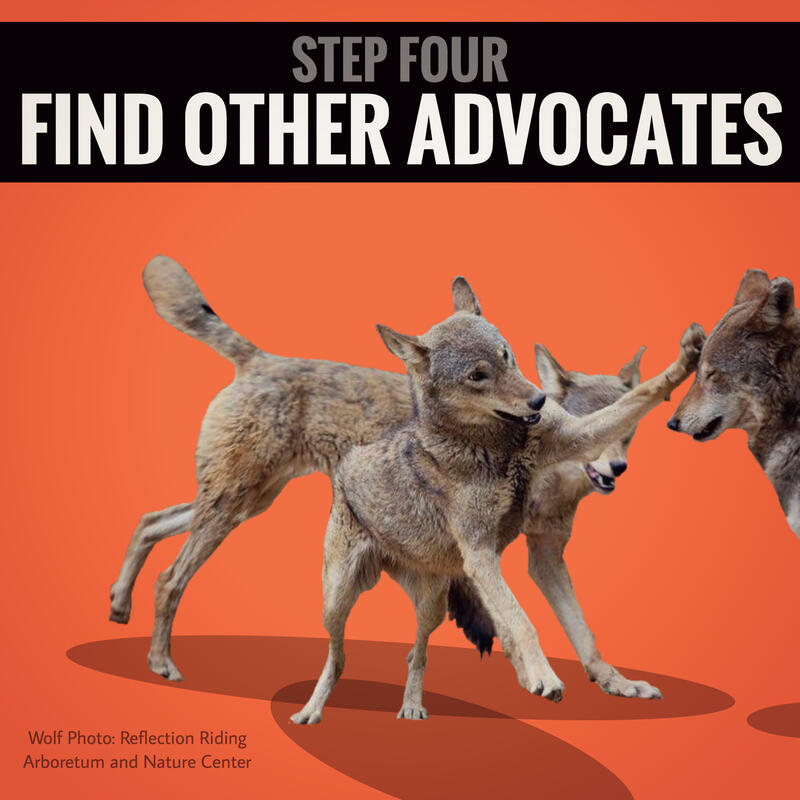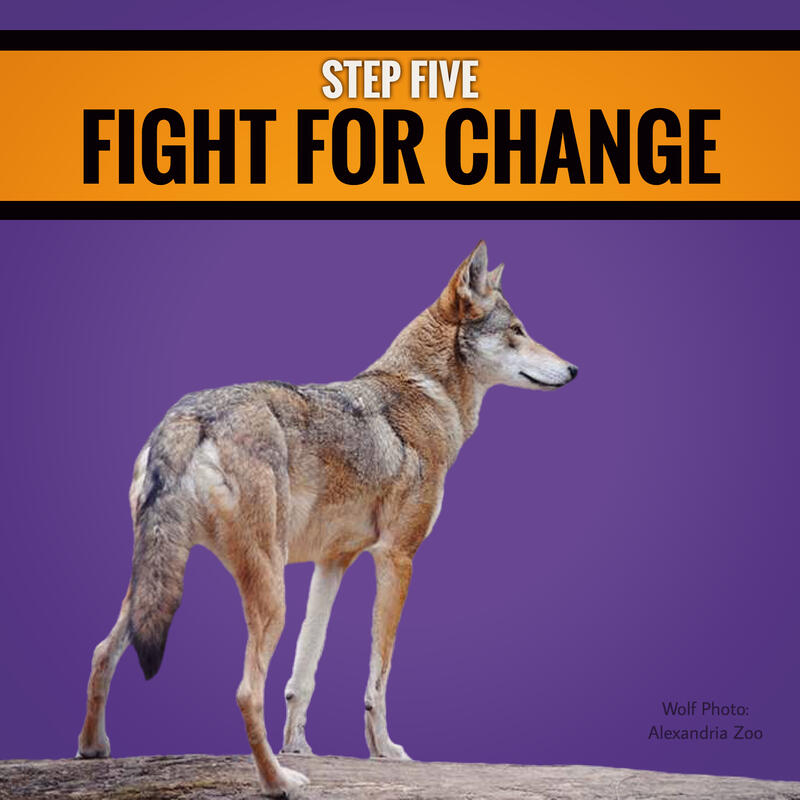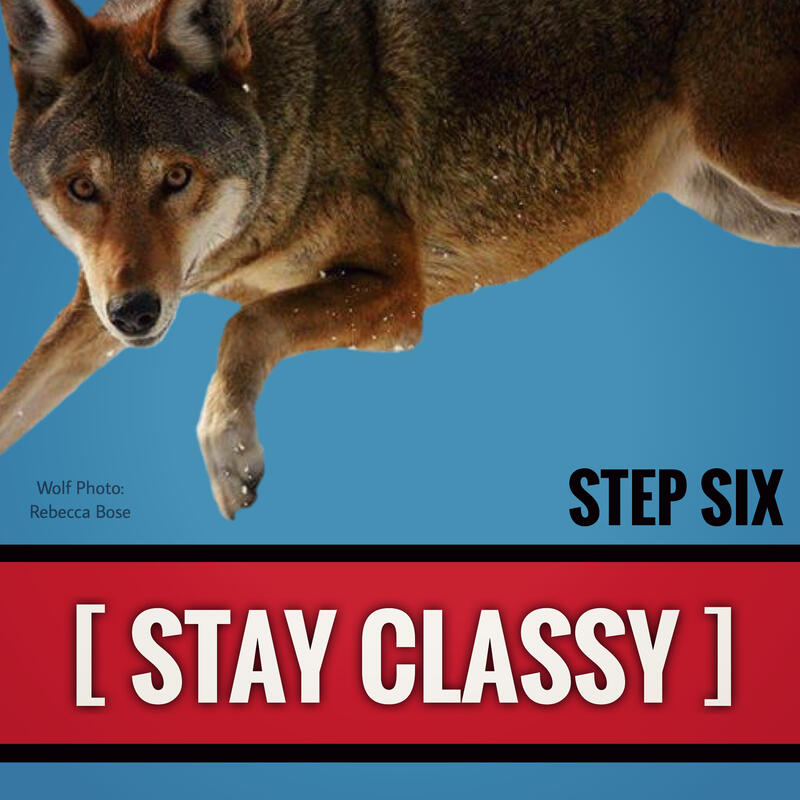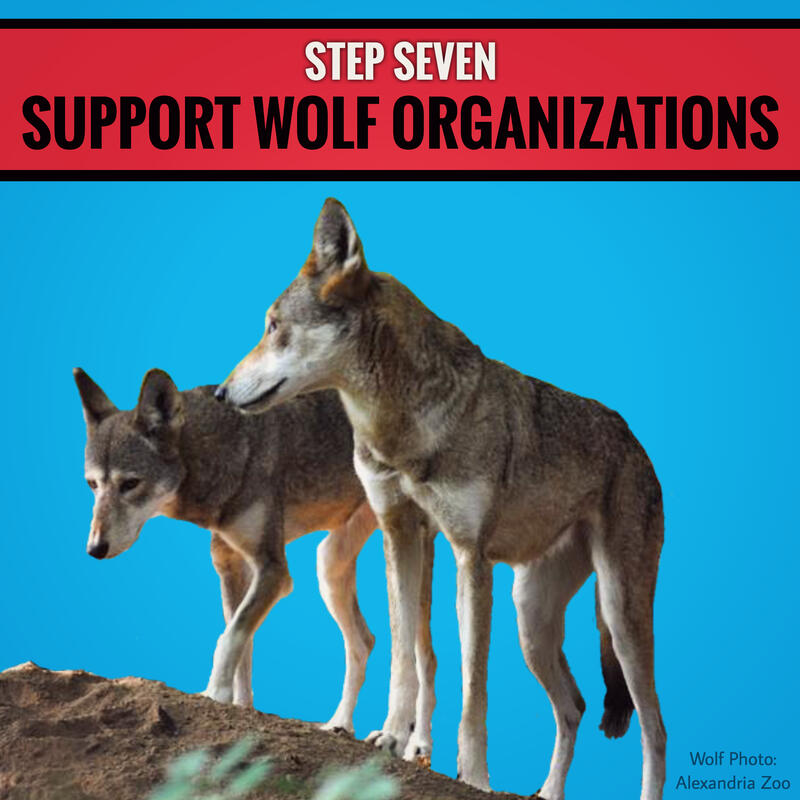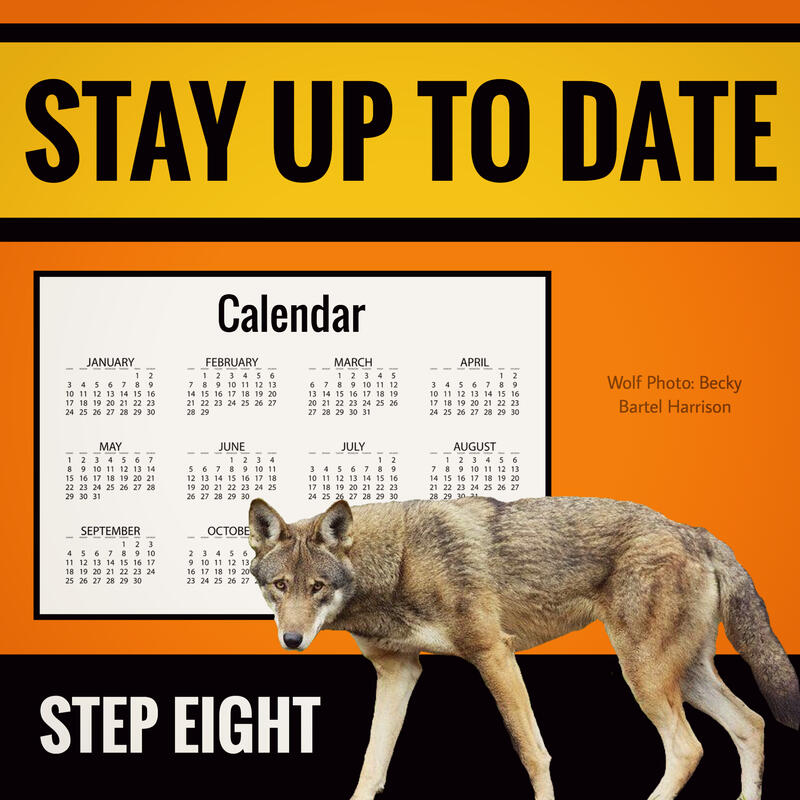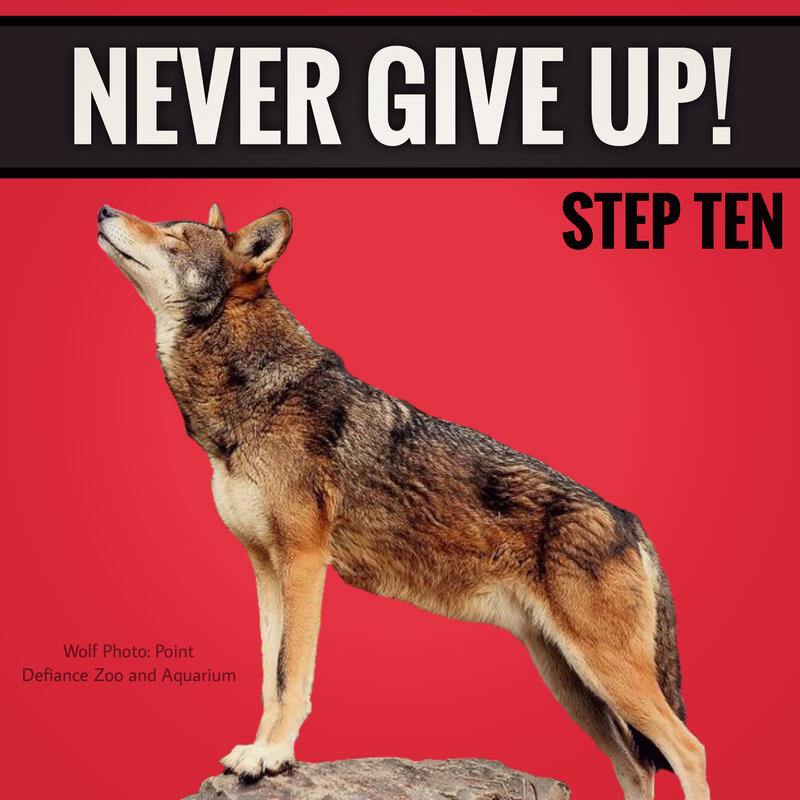Red wolves are critically endangered, but there is still time.
After decades of intensive restoration efforts, the red wolf (Canis rufus) remains at risk of extinction in the wild. Once southeastern North America's top canid predator, the red wolf presently roams free in only a tiny sliver of its historical range. Thought the red wolf species has survived numerous challenges, the future remains uncertain.Red wolves are important.
So is your help.
DID YOU KNOW:
There are as few as
8
red wolves left in the wild.
Learn about red wolf topics!
Red Wolves
Conservation
Awareness
All About Red Wolves
What is a red wolf?
Red wolves are a species of critically-endangered canid that is indigenous to to the eastern and southeastern regions of the North American continent. While they are similar to other types of canids, they are perhaps some of the least well-known of all North American predators. In order to help these special animals survive in the long term, it is extremely important to know as much information about them as possible.
Life Span
Red wolves can live up to seven years in the wild, or up to 15 years in captivity.
Conservation Status
Endangered-Experimental / Non-Essential (in red wolf recovery region)Endangered (elsewhere-if found) (Endangered Species Act classification)Critically-Endangered (International Union for Conservation of Nature classification)
Current Wild Location
The only location with a population of wild red wolves is in and around the Alligator River National Wildlife Refuge and Pocosin Lakes National Wildlife Refuge on the Albemarle Peninsula in northeastern North Carolina, United States of America.
Breeding Season
Second half of January to end of February. Red wolves have an average of five pups per litter with a gestation period of about two months. Wolves can have up to five litters in their lifetime, reaching sexual maturity around 2 years of age.
Taxonomic Designation
(In order of increasing specificity)Domain: Eukarya
Kingdom: Animalia
Phylum: Chordata
Class: Mammalia
Order: Carnivora
Family: Canidae
Genus: Canis
Species: RufusView in ITISRed wolves are not closely related to any other type of wolf.
Red Wolf Rundown
For further insight into red wolf basics, check out this short video about red wolves and red wolf conservation efforts!
What do red wolves look like?
It can be easy to make assumptions about what a red wolf may look like due to their name, however these assumptions can lead to mistakes that can ultimately harm the species. Many of the problems facing red wolves today could be solved at least in part if the public was aware of the differences between red wolves and similar animals such as coyotes. In order for people to help rather than hinder the preservation of Canis rufus, it is important that they know how to identify a red wolf.
How big is a red wolf?
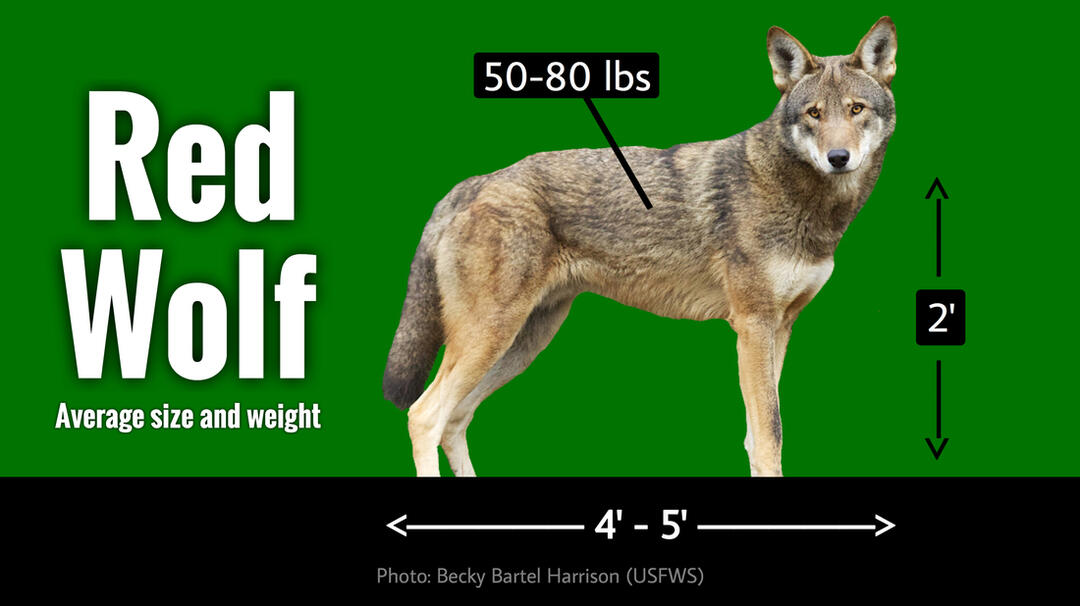
According to the Red Wolf Coalition, red wolves are usually around 4-5 feet long from the nose to the base of the tail, and about two feet tall at the shoulder. These wolves usually weigh anywhere from 50-80 pounds (a mass of approximately 22-36 kilograms) when they reach adult size.
Image source: Becky Bartel Harrison (USFWS) / Edited by Mitch R.
How are red wolves shaped?
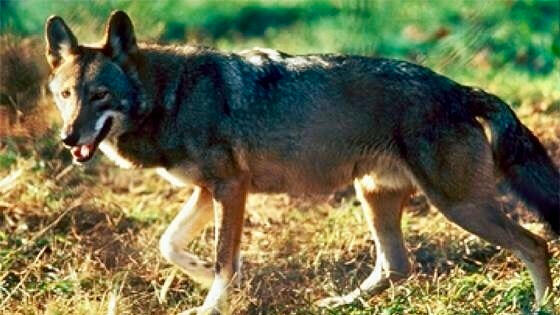
Red wolves have thin, long legs, large ears that are pointy and wide, and large feet, as described by the U.S. Fish and Wildlife Service.
Image source: United States Fish and Wildlife Service
What color(s) are red wolves?

Red wolf coloration around the back, sides, and head can consist of a mix of tannish brown, light grey, black, and rusty red. Around the chest and legs coloration becomes a mix of tan and creamy white.
Image source: United States Fish and Wildlife Service
Coyotes vs Red Wolves
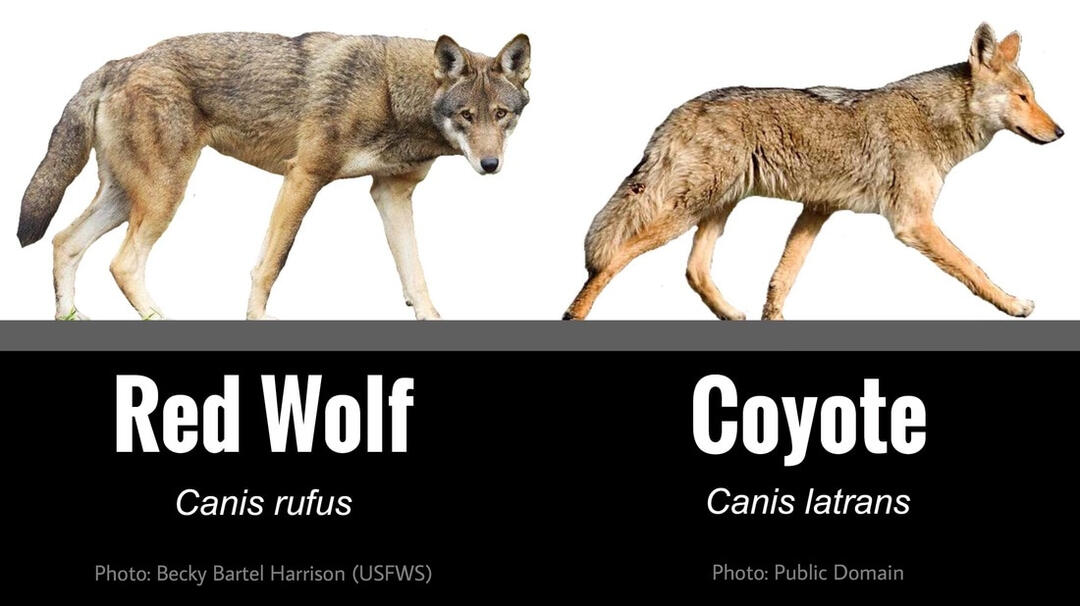
Red wolves are on average slightly larger and a bit heavier than coyotes, however, their similarities make it hard to judge by size alone. Red wolves have wider and shorter muzzles than coyotes, and their eyes are slightly more rounded.
Image source: Combined; edited by Mitch R.
How do red wolves behave?
The life of a red wolf is not as simple as it may seem. There are many complex social, biological, and ecological factors that affect red wolf behavior and interaction with the world around them. From communications between individual red wolves to surviving in a world shared with humans, there are many diverse and complicated components to how red wolves behave both in the wild and in captivity.
What do red wolves eat?

Diet:Red wolves commonly prey on smaller mammals. Creatures such as nutria (which are similar to muskrats), rabbits, raccoons, mice, rats, and other rodents are a frequent source of nutrition for red wolves in the wild. Red wolves may also attempt to hunt white-tailed deer if there is no other prey easily available.Catching Food:Red wolves will often travel for miles in a single day while searching for food. They can hunt alone or together in groups, and can take in up to five pounds of food a day when possible.
Image source (top): Mitch R.
How do red wolves behave around humans?
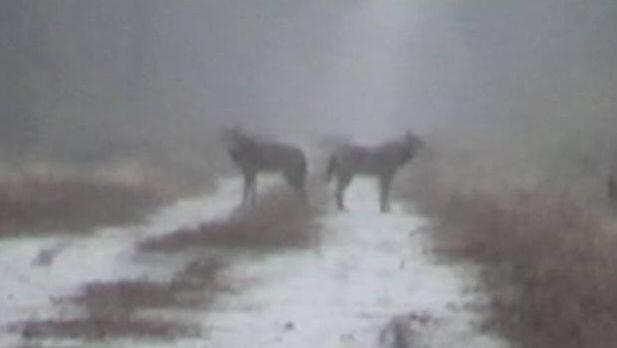
Red wolves are extremely shy and even fearful around humans. They will often do just about anything they can to avoid being near any form of human presence, be it machines, roads, or similar locations. In some cases, however, red wolves will build dens relatively close to farms, where prey (such as deer or mice in the fields) can be spotted more easily. In this way, red wolves can be beneficial to farms in that they help to control various agricultural pests.
Image source: United States Fish and Wildlife Service
How do red wolves behave around each other?

Family life:Red wolves live in family groups (packs) that usually consist of two to five wolves on average. These groups usually have one mated pair, some immediate relations, and the young of that year. Packs of red wolves often work together to find food and to take care of pups.Interaction with "outsider" wolves:Red wolf family groups have their own territories, which they defend passionately against other wild canids, including other red wolves. However, red wolves may find new acquaintances outside of their original family group after leaving to live on their own (which happens at 1-2 years of age) in order to form their own packs or breeding pairs.
Image source: United States Fish and Wildlife Service
How do red wolves communicate?
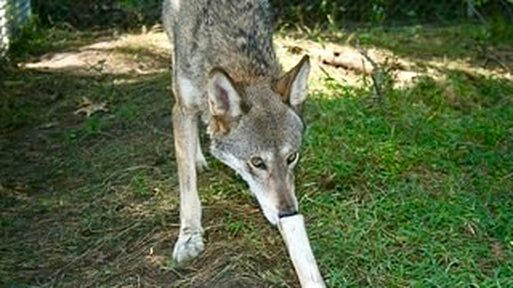
Red wolves use a variety of vocalizations from long sustained howls to short barks. They also use other non-audible communication methods such as scent marking, tail and ear position, and overall body posture. There are still many mysteries involving wolf communication, and research is still revealing new information.Click on the audio player to hear some of the sounds that red wolves make, such as howling, yipping, and barking, for yourself.
Image source: United States Fish and Wildlife Service
What do red wolves do all year?
Red wolves experience a variety of different challenges and opportunities during different seasons and times of the year.
Winter
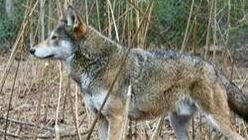
Red wolves typically breed during the second half of winter ( once a year between the second half of January to the end of February). This time of year is also the easiest time for them to find food due to the lack of vegetation to conceal prey as well as tracks left in the snow.
Image source: United States Fish and Wildlife Service
Spring
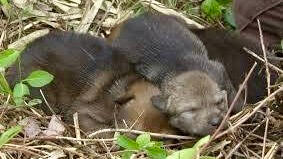
The first half of spring is a time for red wolves to prepare for the arrival of pups by creating dens and finding food sources. Red wolves have a gestation period of about two months, (8-9 weeks), with litters of six pups on average born in April and May.
Image source: United States Fish and Wildlife Service
Summer
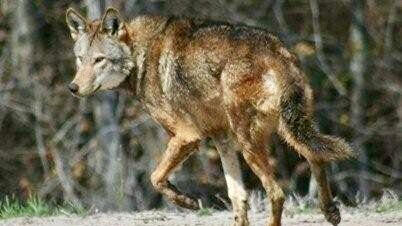
This is often the hardest part of the year for red wolves. Food is harder to find due to concealing vegetation and more frequent movement of prey, and more energy must be expended in the heat in order to find resources. Pups also have to be raised and fed during this time, so red wolf parents are under extra pressure to provide for their families. In coastal areas, inclement weather can also pose a hazard to red wolves due to flooding.
Image source: United States Fish and Wildlife Service
Autumn
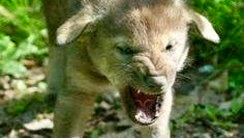
Young red wolves begin to perfect their hunting skills around this time as food grows more abundant and the weather grows colder. To stay warm, red wolves begin to grow longer coats of fur (which were shed in favor of a lighter coat in the spring).
Image source: United States Fish and Wildlife Service
Why are red wolves important?
Red wolves may seem like just another animal, but in fact they are a critical and essential part of the world around them. From balancing the ecosystem to bringing in tourists, red wolves have an important effect on the people and animals that inhabit the Albemarle Peninsula area. There is no replacement for a red wolf, as it is a historic and cultural symbol of nature and society on the North American continent.
Did you know:Red wolves were the first species to successfully be brought back from extinction in the wild due to conservation efforts.
Ecosystemic Balance
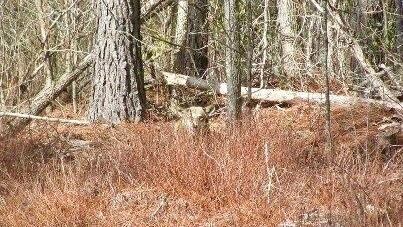
Red wolves are important components of their native ecosystems due to the fact that they are an "umbrella species," meaning they increase the natural health of the areas they live in. By capturing prey that is old or weak, they help in promoting the genetic strength and diversity of many different species of flora and fauna. Any leftover remains of prey can help to fertilize the soil for the plants of the ecosystem, and the depredation of herbivores ensures that plants are consumed in moderation.
Image source: United States Fish and Wildlife Service
History and Culture
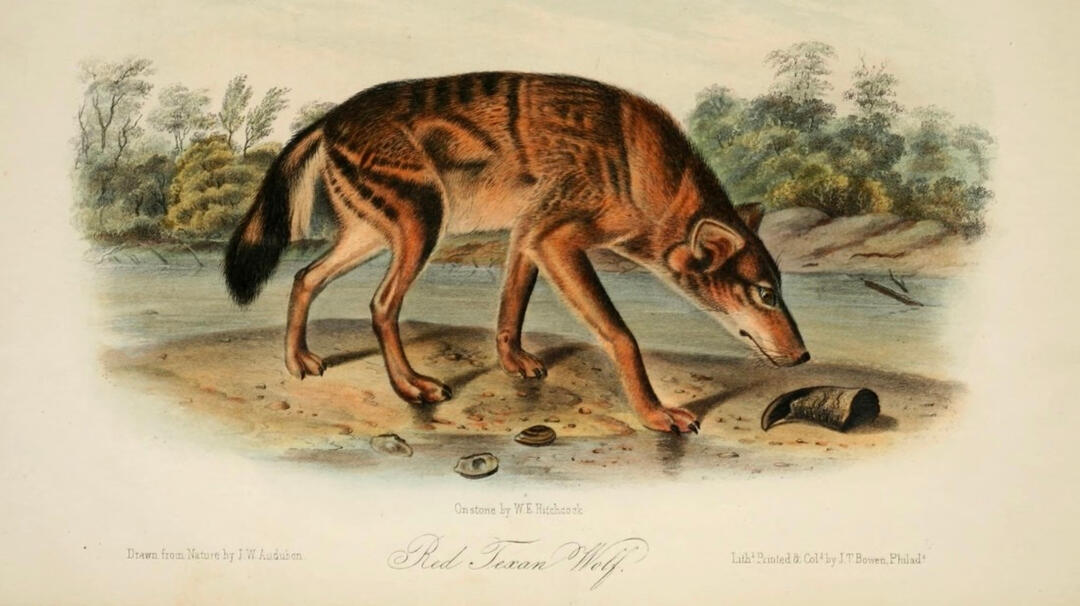
Research has shown that red wolves existed as far back as the eighteenth century, and likely long before that. They are a significant part of native wildlife, and without them a great part of the continent's natural heritage would be lost. Red wolves also play a key role in the cultural practices and beliefs of native peoples, such as the Cherokee tribes, who knew red wolves as the "Wa'ya" and believed that wolves had originally taught humans how to hunt.
Image source (red wolf drawing by John J. Audubon): Public Domain
Tourism and Revenue
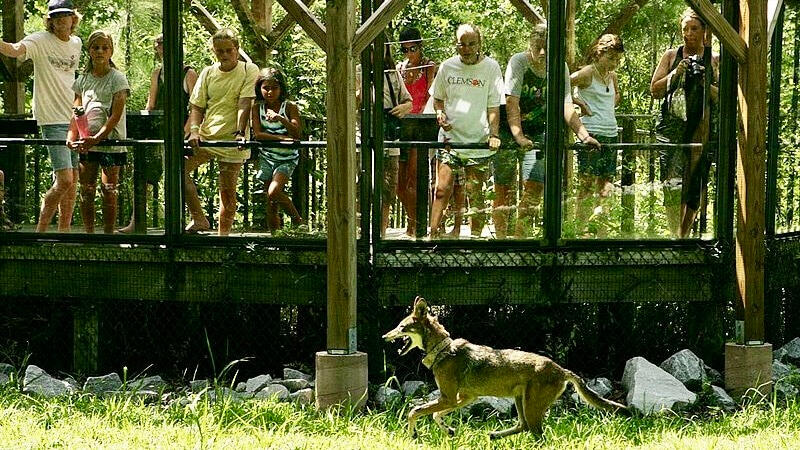
Due to their rarity and the controversies surrounding their existence, red wolves serve as a magnet for ecological tourists and conservation advocates, as well as those interested in unusual animals. The revenue generated from this tourism contributes to the economic sanctity of the towns and other populated areas surrounding the Albemarle peninsula, as tourists will ofteb seek to experience other local attractions and businesses during their red wolf adventures.
Image source: United States Fish and Wildlife Service
Conservation Precedents
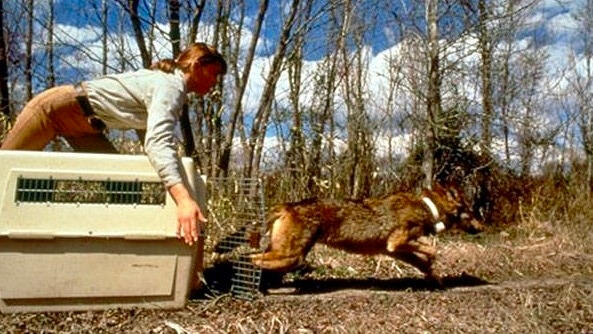
In the 1970's, the last remaining red wolves were captured for captive breeding purposes while the species was declared "extinct in the wild." Since then, conservation efforts have managed to save the red wolf population, part of which lives in the wild, and part of which lives in captivity. Red wolves were the first species to be successfully brought back from extinction in the wild due to conservation efforts, and a loss of red wolves would mean a negation of that achievement.
Image source: United States Fish and Wildlife Service
Educational Value

The long and controversial history of red wolves and red wolf conservation can serve as a source of academic and intellectual discussion. From elementary school activities to college research papers, a study of red wolves can provide a significant source of information on the subjects of ecology, biology, zoology, politics, sociology, and conservation. Red wolves research has been critical in positively influencing the conservation of other animals as well, such as Mexican wolves.
Image source: Public Domain
Pest Control
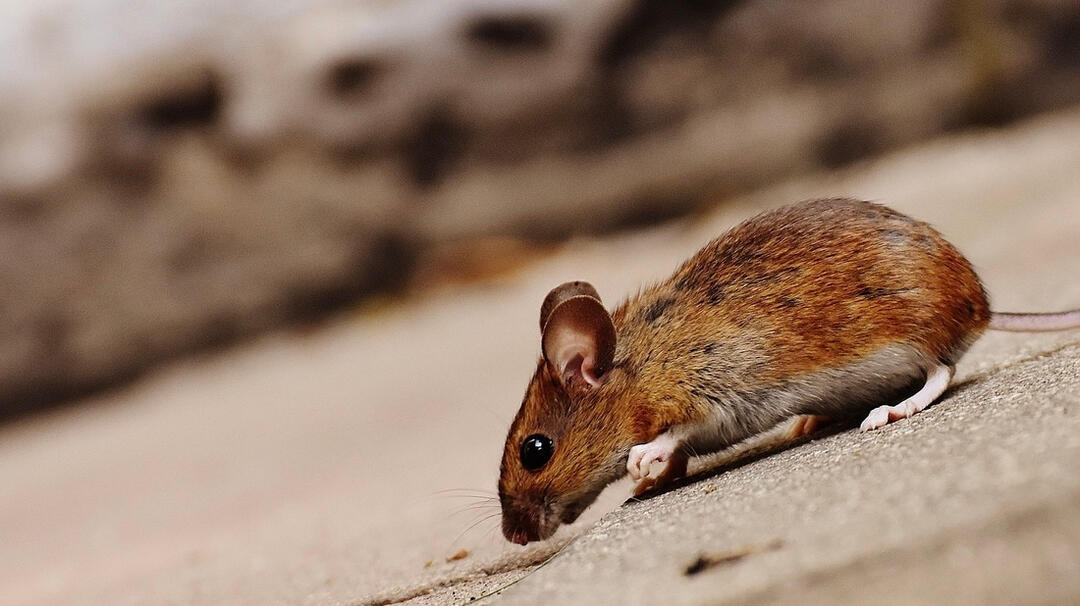
One of the main sources of food for wild red wolves is the rodent population, and as such, red wolves are efficient in reducing the populations of rats, mice and non-native nutria. This behavior can benefit farmers and residents of nearby areas by preventing the destruction of crops due to rodents as well as the spread of diseases. Creatures such as white-tailed deer, which are pests to farms as well, can also be preyed upon by red wolves, thus reducing losses for farmers due to pests and wildlife.
Image source: Public Domain
Information sourced from the Red Wolf Coalition and the U.S. Fish and Wildlife Service.
Issues Facing Red Wolves
There are many different obstacles, both human and natural, that stand in the way of red wolf recovery. From global warming to being hit by cars, red wolves face a great many challenges and dangers. Luckily, most if not all of these issues have the potential to be resolved, provided that the public learns the truth about red wolves and begins to advocate for them.
Hybridization with Coyotes
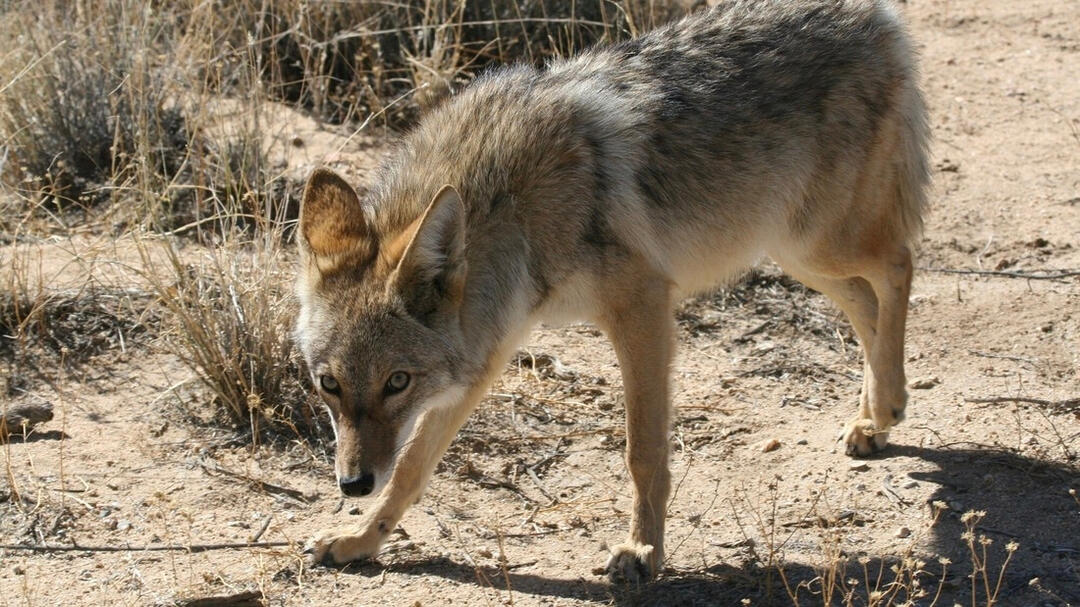
Hybridization with coyotes is one of the most dangerous and immediate threats to red wolves. Due to the relatively limited numbers of other red wolves to potentially breed with, red wolves may sometimes breed with coyotes, producing hybrids that have a negative effect on the red wolf gene pool. To combat this, nearby coyotes are sterilized to prevent further damage to the red wolf population, and the genetic makeup of the red wolf population is monitored.
Image source: Public Domain. Please note that this is an image of a coyote and not a red wolf. The circumstances under which this picture was taken are unknown to us.
Vehicular Hazards
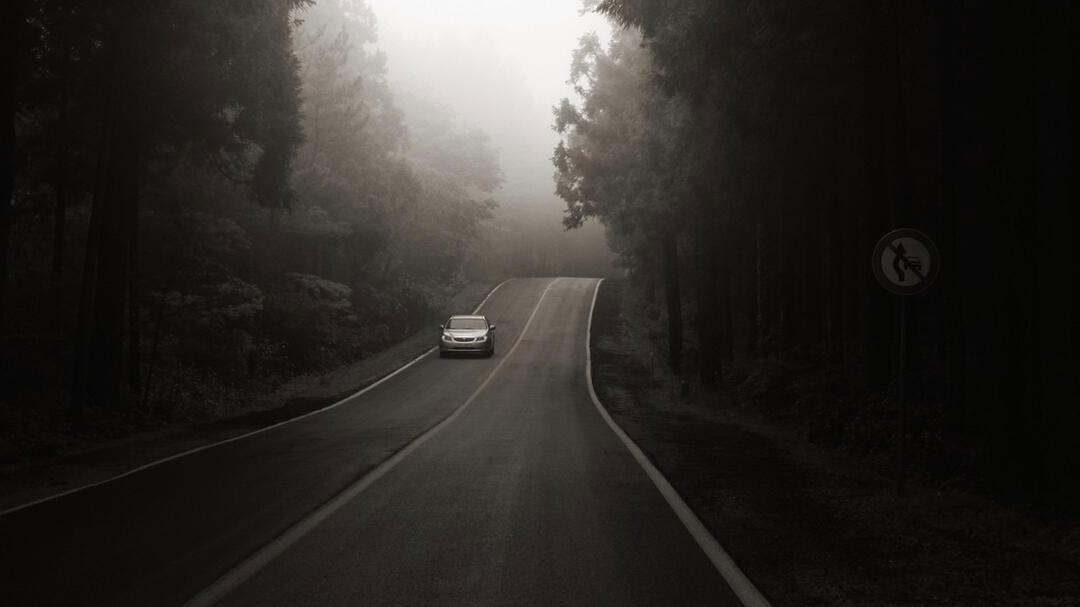
There are a number of public and private roads traversing the Albemarle Peninsula, where red wolves live in the wild. As such, red wolves are prone to getting hit by vehicles, a phenomenon that has accounted for a large amount of wolf mortalities despite signs and warnings. More warnings and driver education are the primary methods being used to combat this dangerous problem.
Image source: Public Domain. Please note that this image does not depict the Albemarle Peninsula and is merely a representation of a similar situation.
Gunshots and Traps

Due to their similar appearance to coyotes at a young age, red wolves may occasionally be mistaken for coyotes and shot. There have also been intentional gunshot mortalities of red wolves (shooting red wolves is a federal crime). Traps set for other animals can also take their toll on the red wolf population. Investigations into these mortalities and rewards for exposing perpetrators help to deter these types of crimes.
Image source: Public Domain. Please note that this (.22 hollow point) is not the correct type of ammunition that would be used on a wolf/coyote, but options for useable images were restricted.
Habitat Loss
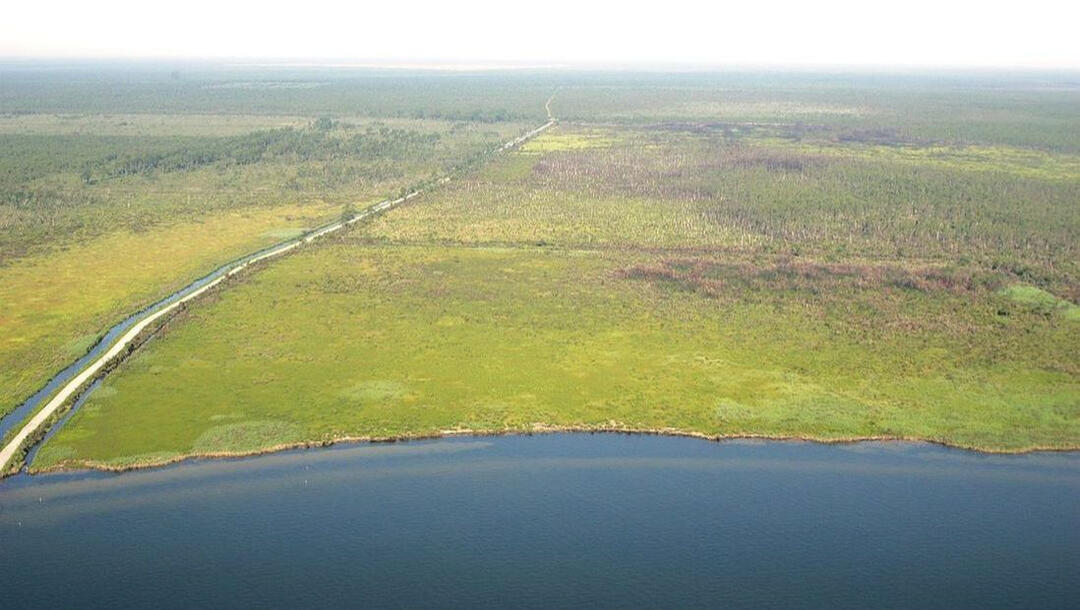
Habitat loss due to human developments such as farms and roadways causes the red wolf population to suffer due to increased human contact and loss of resources. More human contact can lead to more mortalities. Loss of resources would mean increased competition among wolves, leading to starvation or deaths by wolf-wolf conflict. Only mindfulness about developing and conserving the area can solve this issue.
Image source (Alligator River National Wildlife Refuge from above): United States Fish and Wildlife Service
Climate Change
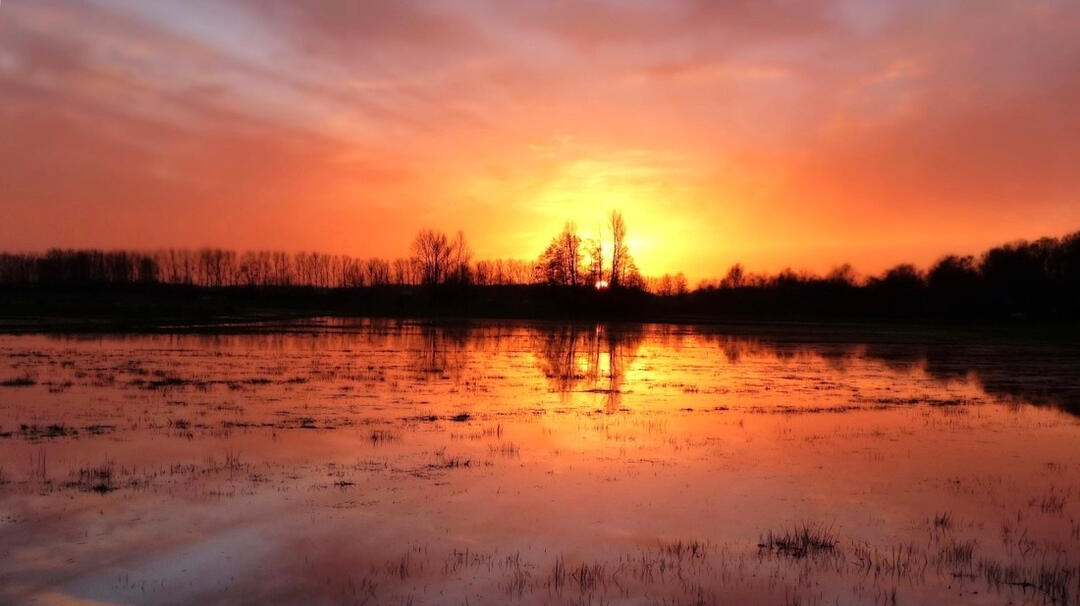
Climate change has a particularly dangerous effect on red wolves in the Albemarle Peninsula region. Sea level rise due to the melting of ice caps contributes to floods in areas red wolves usually live in, and more violent storms can destroy their habitat and food resources. Environmentally-friendly changes in human infrastructure as well as adaptation efforts are the only ways to prevent this problem from worsening.
Image source: Public Domain
Public Controversies
The public's general lack of understanding about red wolves is a significant threat to the future of red wolves. Lack of support and the occasional saboteur greatly increases the difficulty of advocating and researching red wolves. The only way this problem can be resolved is through the widespread sharing of information about red wolves, and the negation of falsehoods and rumors.There are certain trends in opinion amongst those who support and oppose red wolf restoration and protection. These opinions and claims are listed in general terms here.Please note that opinions do vary, and each individual person may hold differing beliefs even if they are generally in support or opposition of red wolf restoration.
Trends and Beliefs of the Supporting Mindset
- Red wolves are an endangered species under the Endangered Species Act and must be protected and restored.
- Red wolves should be able to live freely in at least a portion of their historic range. They were here before humans, and therefore they have a natural place in the environment that should not be ignored or taken away.
- Red wolves help control population levels of prey species such as deer, racoons, nutria, and rodents, and thus increase biodiversity.
- Red wolves provide food for scavengers, and decomposing prey carcasses can help provide nutrients for vegetation.
- Red wolves present little threat to humans, livestock, and pets provided adequate precautions are taken.
- Red wolves are a part of the natural heritage of the southeastern United States and should be protected as such.
- Fears of environmental destruction, the extinction of another species, and loss of scientific research opportunities.
Trends and Beliefs of the Opposing Mindset
- The genetic origins of the red wolf are still a subject of controversy and debate.
- Red wolf habitat is limited, and red wolves may encroach upon private property where they are not wanted. To some, red wolf recovery equates to invasion of private property rights by a federal government program.
Red wolves could wipe out prey populations such as deer, thus damaging the ecosystem.
- Red wolves may carry diseases that could be dangerous to humans, livestock, and pets, or cause them through predation.
- Red wolves might kill domestic pets and some livestock if given the opportunity.
- General aversion to the presence of wolves due to their depiction in popular culture.
- Fears of government/environmental conspiracy, manipulation, and loss of personal property rights.
Diseases
There are a number of diseases that can affect red wolves in the wild. These diseases are often applicable to multiple types of canids, such as dogs, coyotes, and other wolves. While recovery may be possible when a disease or illness is noticed and treated properly, in the wild this does not always occur. Thus, red wolves occasionally end up weakened or killed by disease.Below are listed some of the most prevalent diseases and illnesses affecting red wolves, along with their effects and treatments, if any. The name of each disease or illness can be clicked on for a more extensive description on an external website. The list is in alphabetical order.
Trends and Beliefs of the Supporting Mindset
| Disease | Effects | Treatments |
|---|---|---|
| Canine Distemper | Nervous system damage. Can be fatal. | There is no cure, but recovery is possible. Treatment focuses on symptom management. |
| Canine Parvovirus | Affects heart and/or digestive systems of pups and occasional adults. Can be fatal. | There is no cure, but recovery is possible. Treatment focuses on symptom management. |
| Ehrlichiosis | Can cause lifelong neurological and digestive issues. | Antibiotic treatment can lead to recovery. |
| Gastric Dilation / Volvulus | Extreme digestive and other organ damage. Potentially fatal. | Intensive treatment and surgery. |
| Heartworm | Weakening of the entire body. | Medicine is administered to kill the microfilariae (heartworm offspring). |
| Hookworm | Digestive system damage. Potentially fatal. | Medicine is administered to kill the hookworms. |
| Inflammatory Bowel Disease | Digestive and immune system damage. | There is no cure. Treatment focuses on symptom management. |
| Lyme Disease | Difficulties with bodily functions. | Antibiotics are administered to kill the bacteria. |
| Neoplasia / Cancer | Development of tumors, shutdown of bodily functions. Often fatal. | Treatment depends on the type of cancer. |
| Pneumonia (Bacterial) | Respiratory damage and weakness. | Antibiotics are administered. |
| Sarcoptic Mange | Can cause hair/fur loss and irritation. | Scabicides are used to kill mites. |
Information Sources
(Cited in MLA format unless otherwise stated): Remember to always check your citations in a paper!
- Brzeski, Kristin E., et al. “Infectious Disease and Red Wolf Conservation: Assessment of Disease Occurrence and Associated Risks.” Journal of Mammalogy, vol. 96, no. 4, 26 June 2015, pp. 751–761., doi:10.1093/jmammal/gyv080.- Seeley, Kathryn E., et al. “A Survey Of Diseases In Captive Red Wolves (Canis Rufus), 1997–2012.” Journal of Zoo and Wildlife Medicine, vol. 47, no. 1, Mar. 2016, pp. 83–90., doi:10.1638/2014-0198.1.- Non-MLA: PetMD was also referenced in the table. Even though it applies primarily to pets, in most cases the disease information also applies to red wolves.
Information source: Red Wolf Coalition and the U.S. Fish and Wildlife Service, and other cited sources (in-page).
Red Wolf Habitat
Unlike grey wolves, red wolves are not residents of northern cold environments. Rather, they are native to the southeastern portion of North America, which has a more temperate climate due to its lower latitude and elevation. Over time, the habitat and range of the red wolf has changed dramatically due to environmental factors and human causes.
Overview
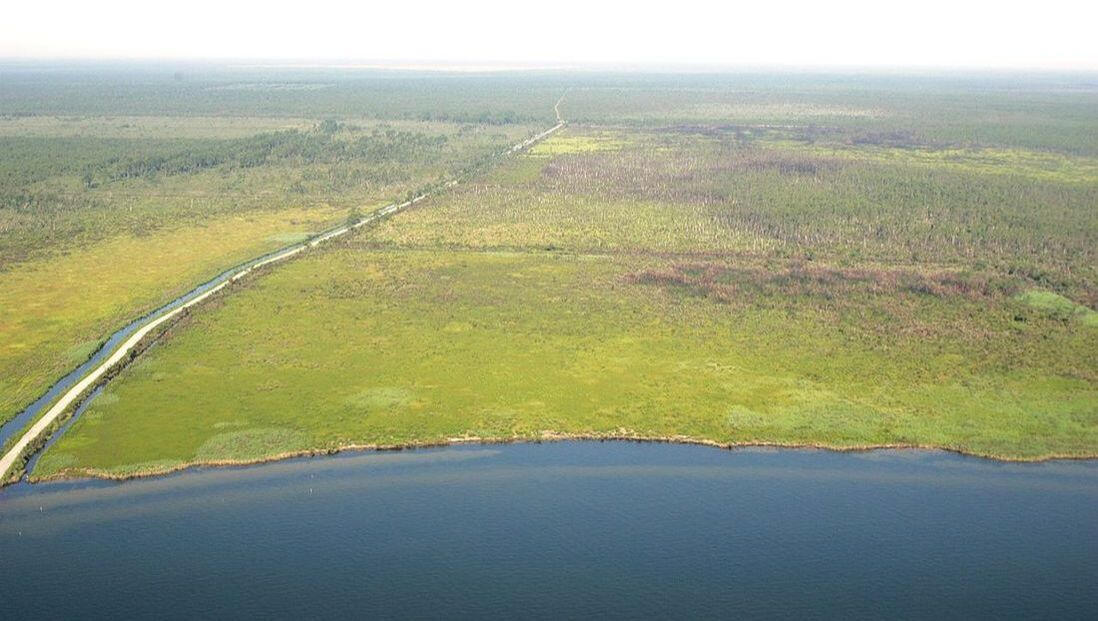
In the past, red wolves inhabited any number of areas such as mountainous regions, plains, woods, and swamps. Today, red wolves primarily inhabit the marshy, wooded areas of the Alligator River National Wildlife Refuge on the Albemarle Peninsula in northeastern North Carolina. Due to extreme habitat loss, this is the only remaining place where larger numbers of red wolves live in the wild. This habitat has many rivers, marshes, and heavily wooded areas as well as farms, roads, and a military bombing range.
Image source (Alligator River National Wildlife Refuge from above): United States Fish and Wildlife Service
Range
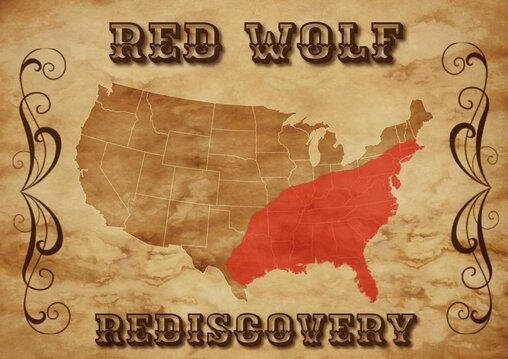
The historical range of the red wolf stretched from around modern-day New York to Florida and out west to about mid-Texas (see image). Today, wild red wolf range is limited to Tyrrell, Dare, Hyde, Washington and Beaufort counties in northeastern North Carolina, USA.
Image source: Mitch R.
Video
This silent video of the Pocosin Lakes National Wildlife Refuge shows the general environment of the Albemarle Peninsula region.
Terrain
Due to the fact that it is surrounded by bays and other waterways that connect to the Atlantic Ocean, the terrain of the Albemarle-Pamlico Peninsula consists of a mix of numerous ponds, marshlands, lakes, rivers, creeks, and canals. In drier areas there are farmlands, small towns, and even a U.S. Navy bombing range.Videos of public demonstrations of military exercises at the Dare County Bombing Range can be seen here and here. Public demonstrations no longer take place, and the range is closed to the public as it is now owned and operated by Northrop Grumman Corporation, an aerospace engineering firm contracted by the U.S. military.
Counties
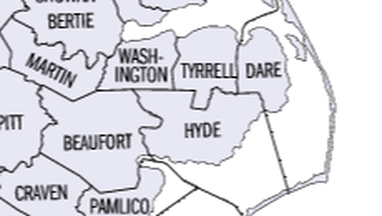
Beaufort County, Dare County, Hyde County, Tyrrell County, and Washington County all lie at least partially on the Albemarle-Pamlico peninsula. Dare County is the location of the Alligator River National Wildlife Refuge.
Image source (counties on the Albemarle-Pamlico Peninsula): United States Census Bureau via Wikimedia Commons (Public Domain)
Towns
These are some of the largest towns and townships on the Albemarle-Pamlico Peninsula. The towns of Kitty Hawk, Manteo, and Nags Head are also nearby on Roanoke Island and the North Carolinian Outer Banks.Remnants of the Buffalo City ghost town are also within the Alligator River National Wildlife Refuge.
Areas
The Albemarle-Pamlico Peninsula is the location of numerous wildlife refuges, game lands, and reserves. You can find the largest ones listed here.- Alligator River Game Land
- Alligator River National Wildlife Refuge
- Dare Game Land
- Emily and Richardson Preyer Buckridge Reserve
- Goose Creek State Park
- Gull Rock Game Land
- Mattamuskeet National Wildlife Refuge
- New Lake Game Land
- Palmetto-Peartree Reserve
- Pocosin Lakes National Wildlife Refuge
- Pungo River Game Land
- Swanquarter National Wildlife Refuge
Notable Bodies of Water
There are many waterways, swamps, lakes, and other water-related geographical features in and around the Albemarle-Pamlico Peninsula (160 with names, and several more unnamed besides). Below are listed just a few of the most notable.- Albemarle Sound
- Alligator River
- Croatan Sound
- Lake Mattamuskeet
- Pamlico Sound
- Pungo RiverTo see the full list of named bodies of water as a .txt file, click here.
Climate
Reviewing the climate and weather patterns of the Albemarle-Pamlico Peninsula is important when attempting to understand the habitats that red wolves live in today. Here are some useful tools designed to help put the local climate into perspective, as well as some examples of extreme weather that can affect the area.An alternative explanation can be found here.
Flooding

Due to the fact that there are numerous marshlands, rivers, lakes, and creeks on the Albemarle-Pamlico peninsula, the area is susceptible to flooding. Large storms and possible sea level rise due to climate change have the potential to exacerbate this situation.
Image source: Public Domain
Thunderstorms
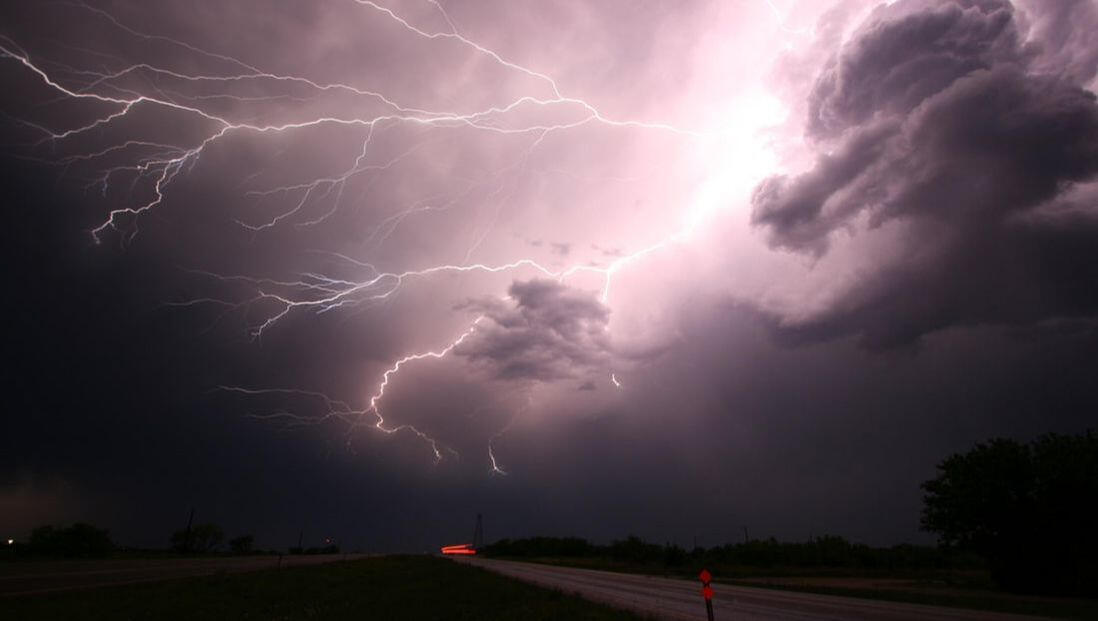
The coastal nature of the Albemarle Peninsula means that it is a hotspot for thunderstorms during the warm months. These storms can bring with them heavy rains and flooding, and can be indications that stronger tropical storms and even hurricanes are on the way.
Image source: Public Domain
Hurricanes
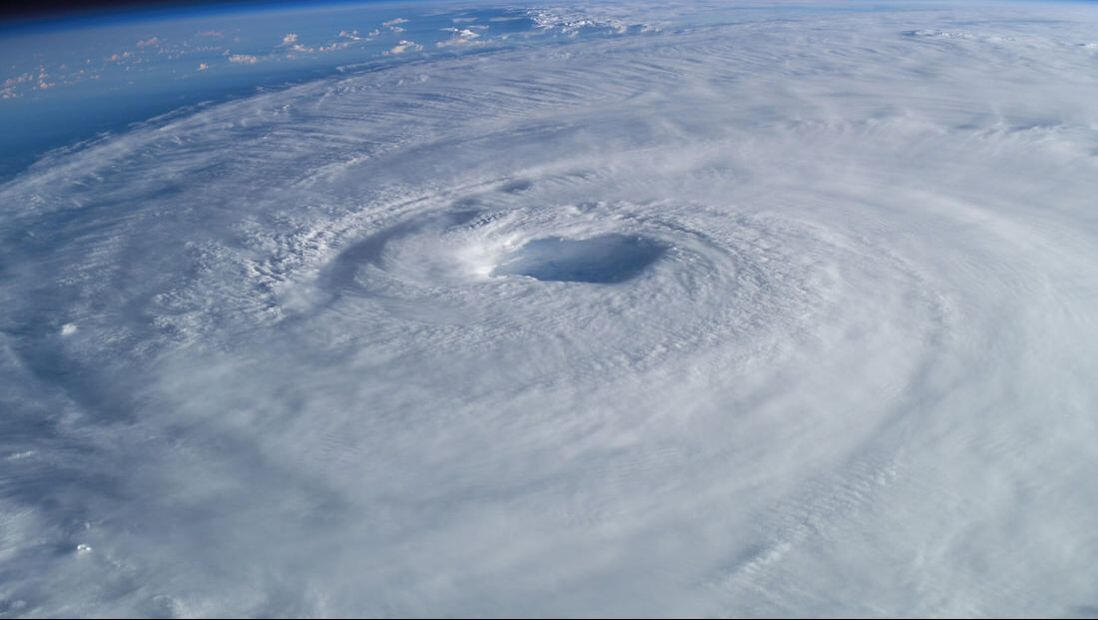
The Albemarle-Pamlico peninsula's location on the eastern North American coast puts it in the potential path of hurricanes. These giant storms can bring with them great storm surges and flooding, as well as strong winds that can pose risks to both wild and human life.
Image source: Mike Trenchard, Earth Sciences & Image Analysis Laboratory, NASA Johnson Space Center via Wikimedia Commons.
Weather Map
Click "Play" at the top of the map to see a live weather radar of the Albemarle-Pamlico Peninsula area!
Forecast
Weather forecast in Columbia, NC. Click for more information (goes to external website).
Trends
This graph from U.S. Climate Data details the average temperatures and rainfall values in Columbia, North Carolina, which is used on this page as a benchmark location for the Albemarle-Pamlico Peninsula near the red wolf recovery area.Average temperatures in this area range from approximately 30°F to 50°F (0°C to 10°C) in January to approximately 70°F to 90°F (21°C to 32°C) in July (values have been rounded).Average rainfall is at its lowest in November at just over 3 inches (7.5 cm), and at its highest in July at just over 6 inches (15 cm).In summary, the Summer months on the Albemarle-Pamlico Peninsula tend to be hot and rainy, while Spring and Fall tend to be drier and cooler. This trend can checked for momentary accuracy at any time by looking at the current forecast on the widget above.
Ecology

The Albemarle-Pamlico Peninsula region is home to an incredibly diverse range of ecosystems full of many types of plants, animals, and aquatic life. Listed below are some of the most notable examples.
Image source: Public Domain. Please note that this is an image of a coyote and not a red wolf. The circumstances under which this picture was taken are unknown to us.
- Sources: United States Fish and Wildlife Service, North Carolina Department of Environmental Quality, and The Secret World of Red Wolves by T. Delene Beeland (pages 8, 9, 11, 17, 45, 53, and 81).
- Additional information about the birds listed above as well as other North Carolinian birds can be found here.
- An alternate explanation of everything above can be found here.
- You can also learn about local efforts to protect these ecosystems here.
- Top image source: Pixabay (Creative Commons). This image was used to build the theme of ecology, and is not necessarily a representation of any specific North Carolinian habitat.
Notable Land Animals
Notable Birds
Notable Marine Life
Insect Life
Click the button below to visit insectidentification.org and learn about some common insects found throughout the state of North Carolina.
Notable Plants
Trees
*Also has a shrub form.
Shrubs
Crops
Ferns
Sedges and Grasses
Flowering Plants
Vines and Ivy
Aquatic Plants
Carnivorous
Other
History
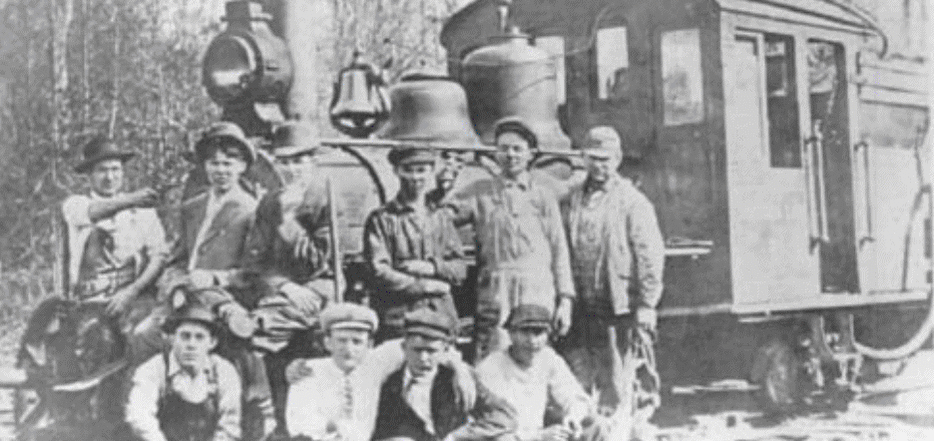
The Albemarle-Pamlico Peninsula region is extremely rich in history with notable events dating back centuries. To fully understand the environment in which red wolf recovery efforts occur, it is useful to be aware of the heritage of the area and to be respectful of its past. The following timeline is designed to aid in gathering historical knowledge, and covers events from 2.6 million years ago to today. Please note that some information is from sources that are compiled from other subsources, such as Wikipedia.
Residents of Buffalo City, NC., a logging municipality which later became a ghost town. Image Source: Wikimedia Commons (Public Domain).
Other useful sources:- In Ancient Albemarle
- Encyclopedia Britannica - North Carolina
- North Carolina History Project
Other useful sources:- Algonquian Native Americans
- Nathaniel Batts
- King Charles II
- John Culpeper
- George Durant
- Thomas Miller
- John L. Roper
Timeline
| When | What | Source |
|---|---|---|
| Beginning 2.6 million years ago | "The topography of the lower coastal plain [forms] during the Ice Ages of the last 2.6 million years.” | SWRW Page 11 |
| 25,000 years ago | “At the beginning of the last Ice Age… sea levels [fall] to about 400 feet below today’s present levels.” | SWRW Page 11 |
| 18,000 years ago | The average temperature begins to rise again. | SWRW Page 11 |
| Before 1584 | Algonquian Native Americans are the sole human inhabitants of the Albemarle Sound area. They survive by growing corn, beans, and squash, as well as by hunting and fishing. Their language was known as Pamlico. | Source 1, Source 2 |
| 1585 | The first English settlement at Roanoke Island is created on the North Carolinian outer banks near the Albemarle-Pamlico Peninsula. It later disappears leaving no trace save the word "CROATOAN" carved in a tree. | Source |
| 1586 | European explorers pass through the sound. | Source |
| 1630's | Formerly-indentured English servants travel south from Virginia in search of good unclaimed land. After crossing the Great Dismal Swamp, they arrive in the Albemarle Sound region and create settlements. Over time, the region grows in social and economic significance. | Source 1, Source 2 |
| 1663 | King Charles II makes the Albemarle Sound area a part of the Province of Carolina. The duty of establishing government is given to eight Lord Proprietors, one of which is the area’s namesake: the First Duke of Albemarle. Free land is offered to help increase settlement. | Source 1, Source 2 |
| 1672 | As the population grows due to persecuted Quakers and other lower-class settlers coming south from Virginia, explorer and translator Nathaniel Batts makes a treaty between settlers and natives limiting English expansion. The treaty mandated that the area south of the Albemarle Sound (namely the Albemarle-Pamlico Peninsula) was to belong to the natives. | Source |
| 1677 | Culpeper’s Rebellion takes place to the north of the Peninsula in response to the Lord Proprietor’s enforcement of the British Navigation Acts that required all colonial imports to be bought from the British. | Source |
| 1710 | The Province of Carolina is divided into a northern half and a southern half. | Source |
| 1712 | The region becomes part of the Province of North-Carolina. It is commonly referred to simply as “North Carolina.” | Source |
| 1729 | North Carolina becomes an official royal colony. | Source |
| 1763 | The Great Dismal Swamp is drained. | Source |
| 1776 | In July, North Carolina becomes a state in the United States of America. | Source |
| 1838 | Lake Landing Canal is dug on the eastern side of Lake Mattamuskeet. This was the first of four canals built over time that have been used to control the water level of the lake to maintain the surrounding ecosystem. Other nearby lakes also gained canals throughout the 1800’s. | Source |
| 1864 | The confederate ironclad warship CSS Albemarle engages in multiple naval battles with Union ships in the Albemarle Sound. It survives every battle until October, when it is sunk in a guerrilla attack. | Source |
| 1890 | The John L. Roper company begins lumber operations at Lee’s Mill by Kendrick Creek in the northwestern region of the Albemarle-Pamlico Peninsula. | Source |
| 1963 | The Pungo National Wildlife Refuge is established in the eastern part of the peninsula. It is later merged into the Pocosin Lakes National Wildlife Refuge. | Source |
| 1984 | The Alligator National Wildlife Refuge is established in the northeastern portion of the peninsula near Roanoke Island. | Source |
| 1987 | “The Albemarle-Pamlico Estuary [is] named an estuary of national significance by Congress.” The first red wolves to be released in the region are introduced into the Alligator River National Wildlife Refuge. | Source 1, Source 2 |
| 1990 | The Pocosin Lakes National Wildlife Refuge is established in the eastern part of the Peninsula. | Source |
| TODAY | The Albemarle-Pamlico Peninsula is an ecologically diverse region with numerous industries, towns, and protected natural areas. | Source |
Demographics
The Albemarle-Pamlico Peninsula is home to many rural communities and towns with smaller populations and natural resource-based economies. Industry on the Albemarle-Pamlico Peninsula is focused on agriculture and lumber.
Information Source: Encyclopedia Britannica
Image Sources: Pixabay (Creative Commons) (Soybeans - Agriculture) (Forestry/Lumber)
Demographics
Check out the website below or visit this link to get a quick insight into the population that lives in and around the Red Wolf Recovery area!
Agriculture
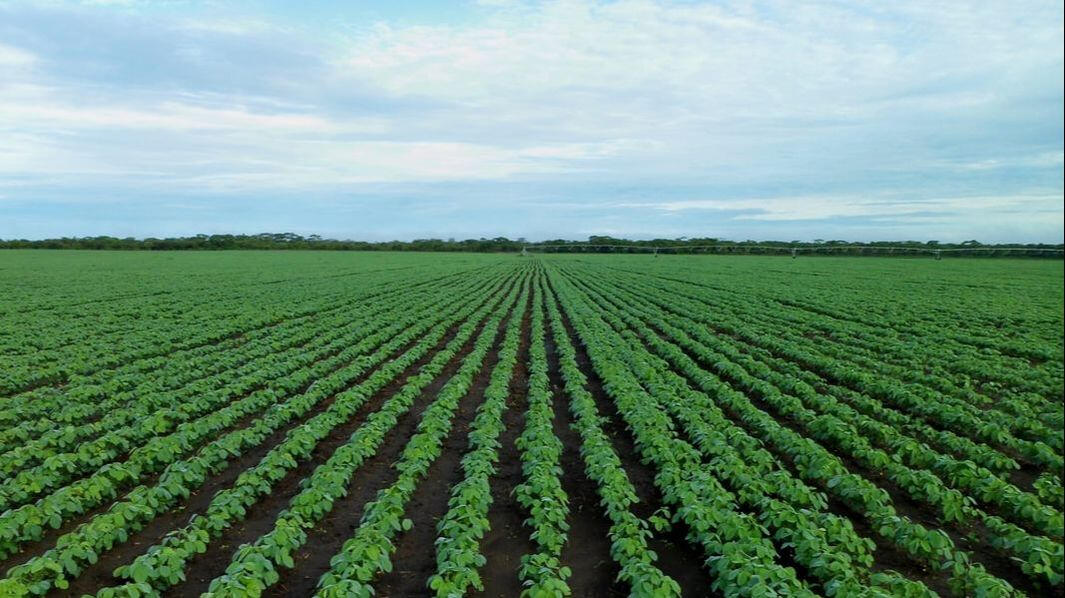
Agriculture on the peninsula primarily revolves around sweet potatoes, dry beans, soybeans, tobacco, cotton, poultry, and pigs.
Forestry / Lumber
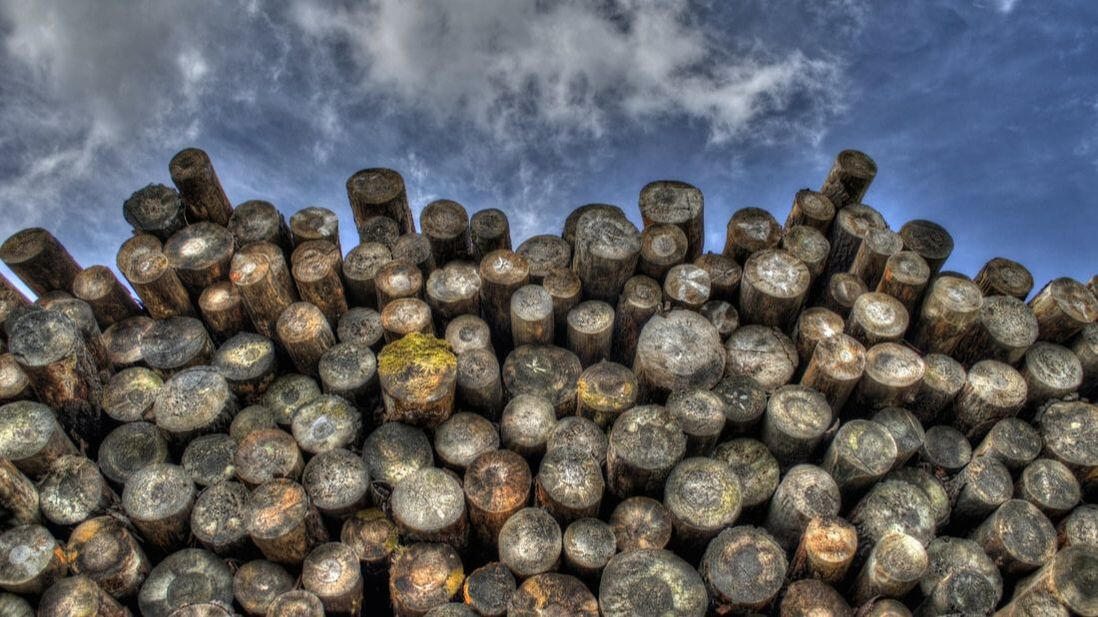
Forestry and logging operations on the Albemarle-Pamlico Peninsula primarily involve lumber from pine trees.
Programs Helping Red Wolves
Red Wolf Species Survival Plan
The Red Wolf Species Survival Plan (RWSSP) is a program created and maintained by over 40 zoos, wildlife sanctuaries, and other facilities across the United States in collaboration with the Association of Zoos and Aquariums. The program consists mainly of captive red wolf management and breeding. In the past, the program has served as a repository for wolves set to be released from captivity into the wild. Participant facilities in the program also take part in extensive public education campaigns to spread the message of red wolf recovery.You can learn more about Species Survival Plans on the AZA's website.
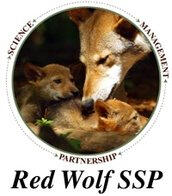
RWSSP Logo: Red Wolf Species Survival Plan
Did you know:The AZA's Red Wolf Species Survival Plan effectively began in 1984 at the Point Defiance Zoo and Aquarium in Tacoma, Washington USA.
Public Education

Through public exhibits at zoos and aquariums across the country, the RWSSP helps provide the public with an opportunity to see red wolves and learn about them in person. Facilities accredited by the AZA to participate in the survival plan often have extensive programs which help to teach both younger and older visitors all about red wolves, their importance, and the challenges they face.
Image source: United States Fish and Wildlife Service
Captive Breeding Program
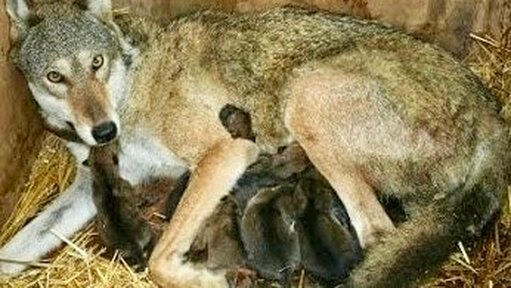
One of the main functions of the RWSSP is it's activities of captive breeding, that is pairing red wolves for breeding purposes to ensure the preservation of genetic diversity. Under some circumstances, captive-bred offspring may be moved between facilities, or even fostered in the wild by other red wolves (although this has not been done for some time due to political and economic controversies).
Image source: United States Fish and Wildlife Service
Scientific Observation
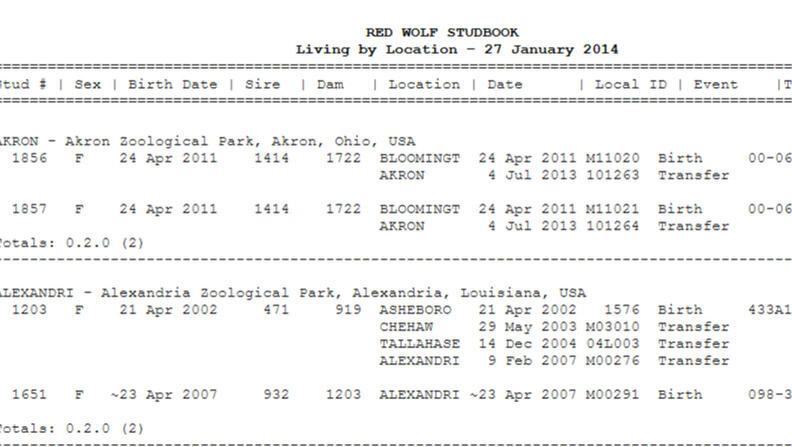
Red wolves in RWSSP participant facilities are often observed by experts, who monitor their behaviors to compare to wild red wolves and ensure the best care possible. Due to the ease with which red wolves can be seen at an SSP facility, more data can be obtained and compiled with minimum invasion of the daily lives or activities of the captive red wolves.
Image source: Screenshot of Red Wolf Species Survival Plan studbook (2013/14)
Care and Protection
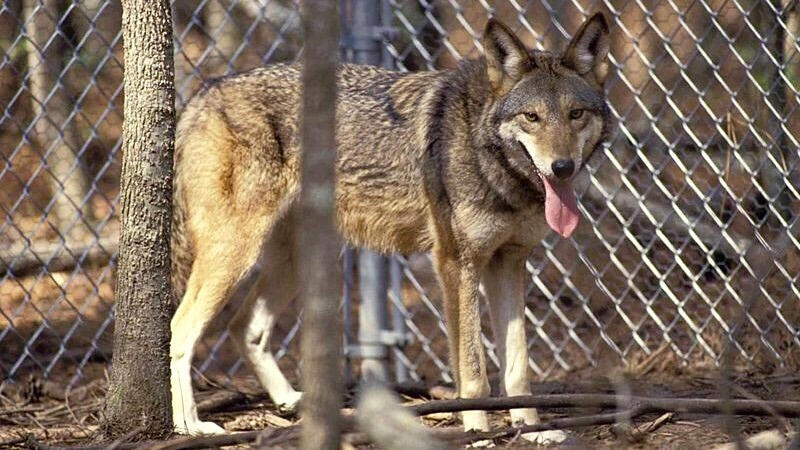
Red wolves in RWSSP facilities are taken care of by zoological and veterinary professionals, who are able to administer and manage the care necessary to keep them healthy. Captive wolves also have regular meals and protection from outside dangers such as weather and poaching. Red wolves live almost twice as long in captivity as they do in the wild.
Image source: United States Fish and Wildlife Service
Information sourced from the Red Wolf Species Survival Plan and the Association of Zoos and Aquariums.
Red Wolf Recovery Program
The Red Wolf Recovery Program (RWRP) is a government (United States Fish and Wildlife Service) run and organized initiative to protect red wolves, which are listed as endangered under the Endangered Species Act. The program's primary activities involve research into the wild sustainability of the red wolf population, as well as ensuring that enough red wolves survive in the wild in order for the species to continue. Public relations with those living in areas of red wolf recovery is another main focus of the program, and one that often leads to controversy.
Did you know:The Red Wolf Recovery Program was initiated in 1973 with the introduction of the Endangered Species Act.
Biological Research
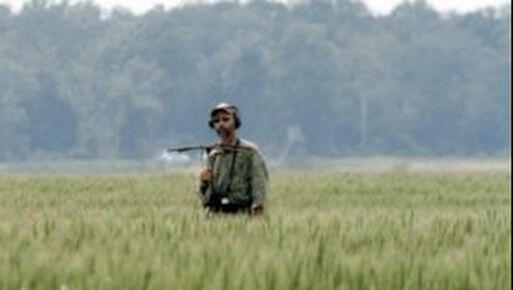
Red Wolf Recovery Program biologists and volunteers carry out numerous research and management related tasks each and every day in areas of red wolf recovery. These tasks include tracking wolves, monitoring population distribution, caring for individual wolves who may have become sick or injured, and collecting genetic samples to analyze the condition of wild red wolves.
Image source: United States Fish and Wildlife Service
Overseeing Recovery Areas
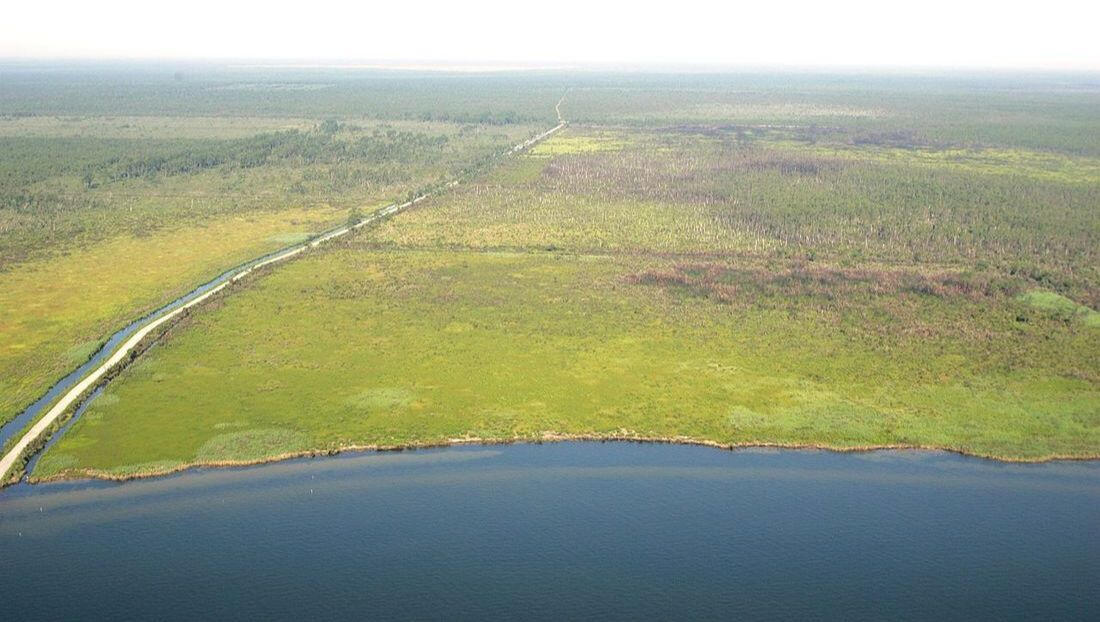
The majority of "boots on the ground" RWRP activities take place in red wolf recovery areas such as the Alligator River National Wildlife Refuge and the Pocosin Lakes National Wildlife Refuge. RWRP biologists monitor the distribution of red wolves in and around these areas as well as the state of the population. The infrastructure of wildlife refuges is overseen by the USFWS.
Image source: United States Fish and Wildlife Service
Overseeing the RWSSP
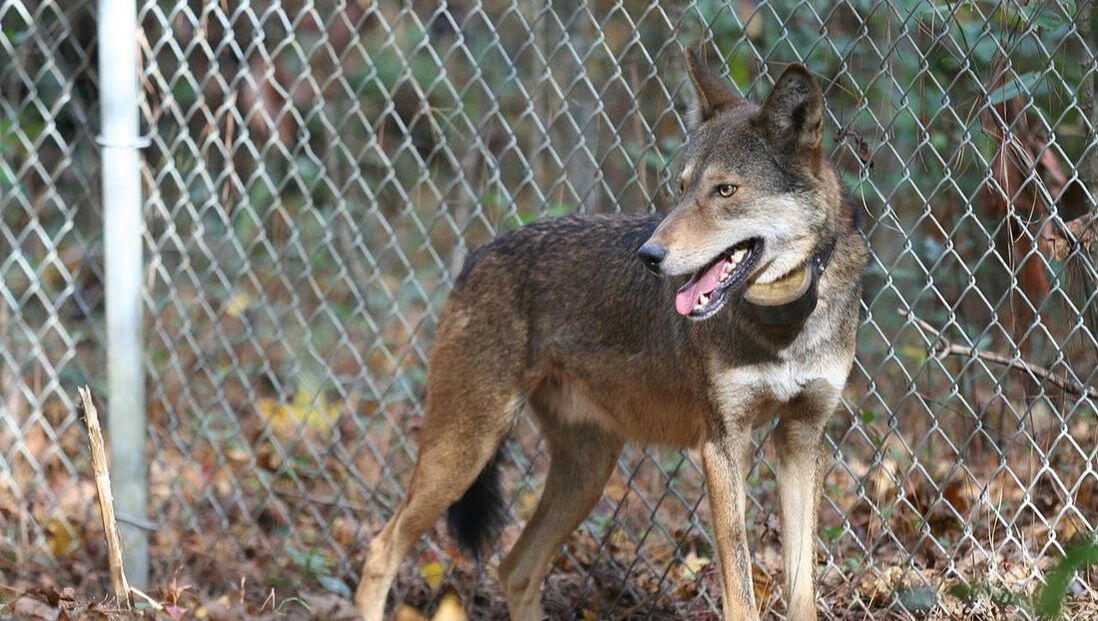
The USFWS works closely with Red Wolf Species Survival Plan participant facilities to ensure the proper maintenance of the captive red wolf population. When the release of red wolves into the wild is authorized, the Service oversees the release of red wolves and monitors red wolf interactions in the wild. The RWRP is also a part of public education efforts to improve the reputation of the red wolf.
Image source: United States Fish and Wildlife Service
General Administration
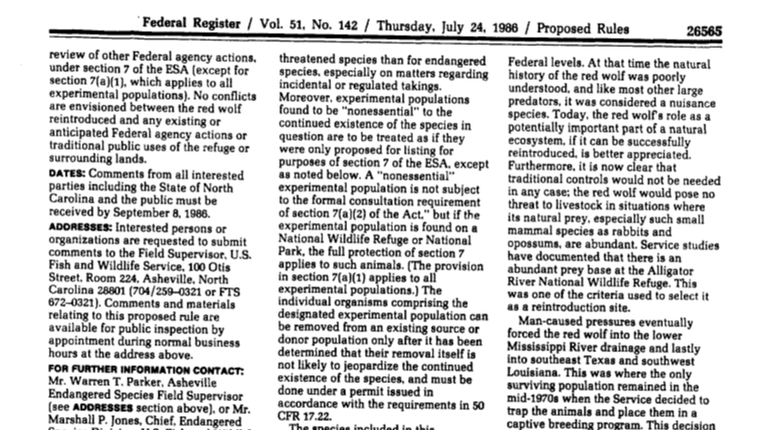
The U.S. Fish and Wildlife Service oversees the activities of the Red Wolf Recovery Program, determining what steps are suitable for red wolf conservation efforts. The Service often conducts internal reviews of the Red Wolf Recovery Program to monitor the condition of the red wolf population and its need for continued conservation efforts.
Image source: Screenshot of Federal Register document of proposed rules for red wolf recovery; USFWS
Information sourced from the United States Fish and Wildlife Service.
Red Wolf Management
Red wolf management takes many different forms and duties depending on the respective circumstances surrounding the wolves that need to be monitored or cared for. Red wolf conservation specialists perform numerous tasks that seek to improve the human understanding of red wolves, and promote positive coexistence with them.
Did you know:Red wolf management happens on three main fronts: In captivity, in the wild, and in the mind of the public.
Captive Management
When managing captive red wolves in Red Wolf Species Survival Plan facilities, conservation specialists focus on a number of key objectives. They must maintain captive population levels at a size that can easily adapt to changes in the red wolf conservation situation and minimize losses of genetic diversity. To do this, Red Wolf Species Survival Plan conservation specialists take care to create thorough reproductive pairing instructions to maintain captive genetic diversity. These instructions detail which wolves should go to specific facilities and be paired together for eventual breeding.Conservation specialists also must take care of captive red wolves by providing them with appropriate food, shelter, and veterinary care if needed. Red wolf enclosures in conservation facilities must adhere to strict guidelines that can ensure the safety and comfort of the wolves and any people who go to see them. Management personnel at accessible conservation facilities also take part in public education about red wolves, giving visitors a chance to learn more about the animals and the need for public support for their conservation.
Image source (1): United States Fish and Wildlife Service
Image source (2): United States Fish and Wildlife Service
Wild Management
When managing and researching the wild red wolf population, a primary objective for specialists is to keep the red wolf population stable and diverse. One of the main aspects of this goal is that of avoiding red wolf hybridization with coyotes. A primary method used to prevent this phenomenon involves the introduction of sterilized (technically spayed or neutered) coyotes to hold territories in red wolf recovery areas. Since these sterilized coyotes cannot breed, there is no risk of them creating hybrid animals with red wolves. Furthermore, sterilized coyotes will hold territories in red wolf recovery areas, thus keeping breeding coyotes out and away from red wolves.Due to their small population size, red wolves are also vulnerable to inbreeding depression, that is, the loss of genetic diversity due to breeding between wolves that are already closely related. This problem is closely watched by researchers to determine how much of a risk this phenomenon is. Wild red wolves are monitored using technology such as VHF (Very High Frequency) radio tracking collars, microchips, and fecal sample analysis to see where each wolf spends its time and to determine whether there is a risk of a closely-related breeding pair forming. Specialists also monitor the territorial distributions of individual red wolves and red wolf groups to keep tabs on the genetic distribution of the wild population.The monitoring of diseases carried by coyotes is also one important facet of wild red wolf management. As coyote-borne diseases can easily spread to red wolves, care is taken to ensure that these diseases have as little opportunity to spread as possible. This often involves removing coyotes from recovery areas, or treating the population with certain medicines to combat diseases.Monitoring interactions with humans is one final and extremely critical aspect of wild red wolf management. Wolves are vulnerable to habitat loss, motor vehicle accidents, and accidental killings due to being mistaken for coyotes, and as such information on red wolf-human interactions is an important component of red wolf research. This information is used to create educational campaigns for the public that promote the safety of both red wolves and humans as well as public receptiveness towards red wolf reintroduction.
Image source (1): Coyote being fitted with tracking collar; United States Fish and Wildlife Service
Image source (2): United States Fish and Wildlife Service
Image source (3): United States Fish and Wildlife Service
Transfers
When authorized*, the release of red wolves into the wild is a complex process with different plans depending on variables such as the age of the wolves to be released and the original captive facility the wolves are coming from.When preparing to release adult red wolves into the wild, conservation specialists first allow red wolves to go through a conditioning period in an enclosed area within their new environment. This process allows the wolves to acclimate to the surrounding climate and ecosystem, while adapting to a new diet that is closer to what the wolves would eat in the wild.When transferring pups from captive breeding facilities into the wild, the technique of pup fostering is employed, in which captive-born pups are carefully inserted into a wild red wolf den with wild-born red wolf pups. This procedure is completed while the mother red wolf is temporarily away from her den (either temporarily sedated, looking for food, or in some cases merely watching from a safe distance). Captive born pups are microchipped and often scent-matched to the wild-born pups, after which they are huddled together. The conservation specialist team will usually monitor the pup's development over time in order to ensure a successful release.Released red wolves are tracked by conservation specialists in order to monitor their interactions with wild red wolves and other ecosystemic variables as well as their overall survival rate. VHF (Very High Frequency) radio collars, microchips, and rubber traps are key technological methods used to track wolves, as well as scat analysis.Red wolves are rarely captured and taken permanently out of the wild, but in cases involving a need for veterinary care for a wild red wolf, nets, sedatives, or soft traps are employed to safely remove wolves from the wild without harming them. The wolves are then treated, documented, and re-released into the wild once more.*It is important to note that as of 2015 - present, red wolf releases into the wild have been (likely temporarily) suspended (deauthorized) by the United States Fish and Wildlife Service.
Image source (1): United States Fish and Wildlife Service
Image source (2): United States Fish and Wildlife Service (low-res image)
Image source (3): United States Fish and Wildlife Service
Information sourced from the United States Fish and Wildlife Service, the Red Wolf Species Survival Plan, the Red Wolf Coalition, and The Secret World of Red Wolves by T. Delene Beeland.
Red Wolf History
Red wolves have been through a lot, and so have the people who work to protect them. Over the years many important tweaks have been made to red wolf recovery practices and programs that have influenced the status of red wolves today. While some changes have been positive and some have been negative, every event that has happened in relation to red wolves is proof that conserving a species is no small task.
Did you know:Red wolves were first described in detail by William Bartram in the 1700's.
Firsts in the Field
The Red Wolf Recovery Program has had an important influence on methods of animal conservation and protection in the United States. Due to advancements in restoration practices made in the RWRP, programs for other creatures such as Mexican wolves, black footed ferrets, and California condors have been able to find successes in preserving the natural diversity of various ecosystems across the country.
- Red wolves were the first listed species to undergo a controlled extinction in the wild with the intent of later reintroduction as overseen by the U.S. Fish and Wildlife Service. All wild red wolves were removed from the wild, bred in captivity, and partially released back into a part of their historic range.
- The Red Wolf Recovery Program was one of the first government-overseen carnivore captive breeding programs.
- Red wolves were the first type of wolf to be re-released into a wild environment in the United States.
- Wolf management practices such as helicopter tranquilization were first used on red wolves within the continental US.
- Red wolves were some of the first animals listed under the Endangered Species Act of 1973.
The Timeline
Below is a comprehensive timeline of events throughout the history of red wolves and red wolf recovery. The time of occurrence is on the left, and a description of the events that occurred is on the right.
| When | What Happened |
|---|---|
| Before Human Settlement in North America | The natural range of the red wolf stretched from modern-day Texas in the west to the Florida peninsula in the southeast, and from the southern coasts of North America up to modern-day Massachusetts. |
| 18th Century | William Bartram is one of the first to describe red wolves in detail, comparing them to gray wolves from the north. |
| 19th Century | John James Audubon adds detail to the scientific description of the red wolf, giving it the name Canis lupus rufus, which is now simply Canis rufus. |
| 1905 | The red wolf is officially recognized as a distinct species. |
| 1962 | Howard McCarley informs the scientific community that red wolves are in danger of extinction. |
| 1966 | The Endangered Species Preservation Act is created, and red wolves are listed as endangered under the purview of the law. |
| 1968 | The U.S. Fish and Wildlife Service begins to study red wolves more closely in southeast Texas and southeastern Louisiana. |
| 1969 | The Point Defiance Zoo and Aquarium becomes home to the first captive red wolf, initiating the red wolf captive breeding campaign to save the species. |
| 1973 | The Endangered Species Act is made into a federal law, and the Red Wolf Recovery Program is initiated. From this time until 1980, researchers begin to capture wild canids from the Louisiana and Texas area, putting painstaking effort into determining which animals are fully-blooded red wolves, hybrids, and coyotes. In the end, only 17 of these captured canids are true red wolves. |
| 1977 | In Spring, the Point Defiance Zoo and Aquarium becomes home to the first litter of red wolf pups born in captivity. |
| 1978 | Two red wolves are temporarily released on Bull's Island in Cape Romain National Wildlife Refuge in South Carolina. Over the next 11 days, red wolf tracking methods are tested and perfected. The wolves are recaptured after the test period concludes. |
| 1980 | Red wolves are officially declared "biologically extinct in the wild," and the last remaining wild red wolves are captured and brought into captivity in order to facilitate captive breeding programs with the goal of future reintroduction into the wild. |
| 1984 | The Point Defiance Zoo and Aquarium receives approval from the Association of Zoos and Aquariums to start the Red Wolf Species Survival Plan. Four additional conservation institutions are recruited to assist in holding and maintaining captive red wolves for captive breeding purposes. |
| 1984 | The Alligator River National Wildlife Refuge is established in northeastern North Carolina. It eventually becomes home to a reintroduced wild population of red wolves. |
| 1986 | Legal preparations are made to introduce mated pairs of red wolves into the Alligator River National Wildlife Refuge. |
| 1987 | Beginning with eight wolves (four male-female pairs), red wolves begin to be released into the Alligator River National Wildlife Refuge on the Albemarle Peninsula of North Carolina. |
| 1987 | Bull's Island in South Carolina begins to be used as an island breeding location for the Red Wolf Recovery Program. Pups born there were to be relocated to the main wild population location in North Carolina after they were raised to maturity. |
| 1988 | The first wild litter of the Red Wolf Recovery Program is born in the Alligator River National Wildlife Refuge. |
| 1990 | The Pocosin Lakes National Wildlife Refuge is established near the Alligator River National Wildlife Refuge, later becoming an extension of the wild red wolf recovery area. |
| 1991 | Great Smoky Mountains National Park is approved as another location for a wild red wolf population. |
| 1993 | Great Smoky Mountains National Park sees its first litter of wild red wolf pups born. |
| 1993 | Red wolves begin to be released into the Pocosin Lakes National Wildlife Refuge. |
| 1995 | A new law is introduced in the Senate that would stop all funding for the red wolf recovery program and narrowly defeated. |
| 1995 | North Carolina passes a law allowing private landowners to kill red wolves on their property. |
| 1995 | Red wolves as a species become a subject of controversy as some research indicates red wolves may not be a true species after all. Future research returns mixed results, with some studies verifying that red wolves are a distinct species and others concluding that they are not. |
| 1998 | All wolves in the Great Smoky Mountains National Park are relocated to the Alligator River National Wildlife Refuge. The program in the Great Smoky Mountains National Park is shut down. |
| 2000 | A modifiable system for wild red wolf restoration is set in place to prevent hybridization with coyotes. |
| 2005 | All red wolves on Bull's Island are relocated to the Alligator River National Wildlife Refuge or captive breeding facilities, and the propagation project on the island is shut down. |
| 2007 | The Point Defiance Zoo and Aquarium and Red Wolf Recovery Program receive North American Conservation Award top honors from the Association of Zoos and Aquariums for work done to restore red wolves. |
| 2015 | Encouraged by the North Carolina Wildlife Resources Commission, the United States Fish and Wildlife Service begins reevaluating its plan and stance on red wolf recovery, even considering terminating all recovery programs altogether. |
| 2016 | A federal court, in response to a suit brought by the Red Wolf Coalition and two other groups, issued a preliminary injunction ruling that the USFWS cannot capture and kill - or authorize private landowners to capture and kill - red wolves on private land unless they pose an imminent threat to people or property. |
| 2016 | A lawsuit filed by the Southern Environmental Law Center (on behalf of the Red Wolf Coalition and two other groups) against the USFWS is currently underway. The suit alleges that the Service is not fulfilling its legal responsibilities under the Endangered Species Act to recover the red wolf. |
| 2016 | New rules proposed by the USFWS recommend restricting the world's only wild red wolves to two small areas of federal land in Dare County, NC. The proposal also includes removing red wolves from the wild throughout the rest of the 5-county red wolf recovery region and placing them in captivity. |
| 2018 | The USFWS releases its conclusions found during a 5-year review of the red wolf recovery program. The conclusions recommend that the red wolf stay listed as endangered under the ESA. |
| NOW | Fewer than 45 red wolves remain in the wild. |
Information sourced from the United States Fish and Wildlife Service, the Red Wolf Species Survival Plan, the Red Wolf Coalition, and The Secret World of Red Wolves by T. Delene Beeland.
Red Wolf Statistics
When researching red wolves on a personal or academic level, qualitative and secondary information does not always provide the full picture. It is often useful to look at quantitative information as well, such as population data, mortality data and more. These information types are compiled on this page, as well as on a more detailed spreadsheet document which is linked in numerous places below.For information sources and a closer look at the data used to create these graphs, click here.
Red Wolf Population Statistical Trends
Red wolf population data covers quantitative information about the growth and maintenance of the wild and captive components of the red wolf population, as well as some important factors that influence the sustainability of its numbers.
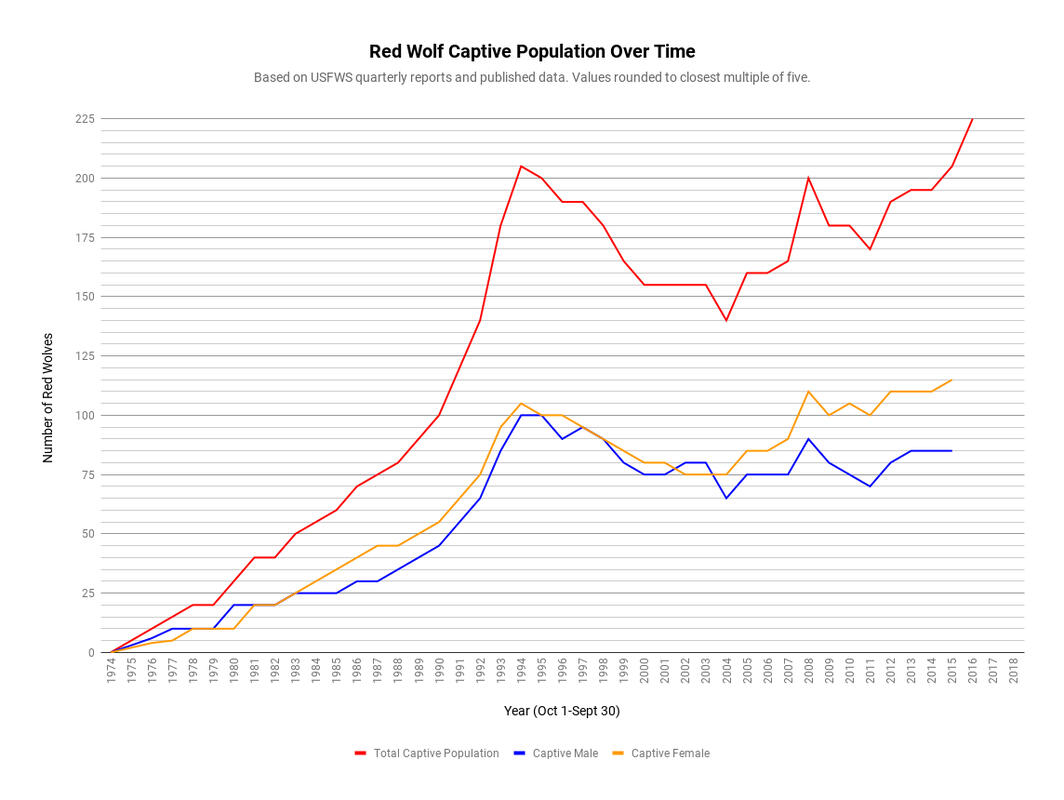
During the 1970's, the last remaining red wolves were captured and moved to captive breeding facilities to save the species, effectively rendering the red wolf biologically extinct in the wild in 1980. Until 1994, the captive red wolf population rose relatively steadily towards the current captive population target of roughly 330 red wolves. Between 1995 and 2010, the captive red wolf population hovered around the 175-wolf mark. From 2011 to the present, the captive red wolf population has once again risen relatively steadily towards the 330-wolf target.During the 1974-1983 and 1995-2003 periods, the ratio of captive male to female red wolves remained relatively stable at close to 1:1.During the 1984-1994 and 2004-present periods, the population of captive female red wolves was notably higher than that of captive male red wolves.
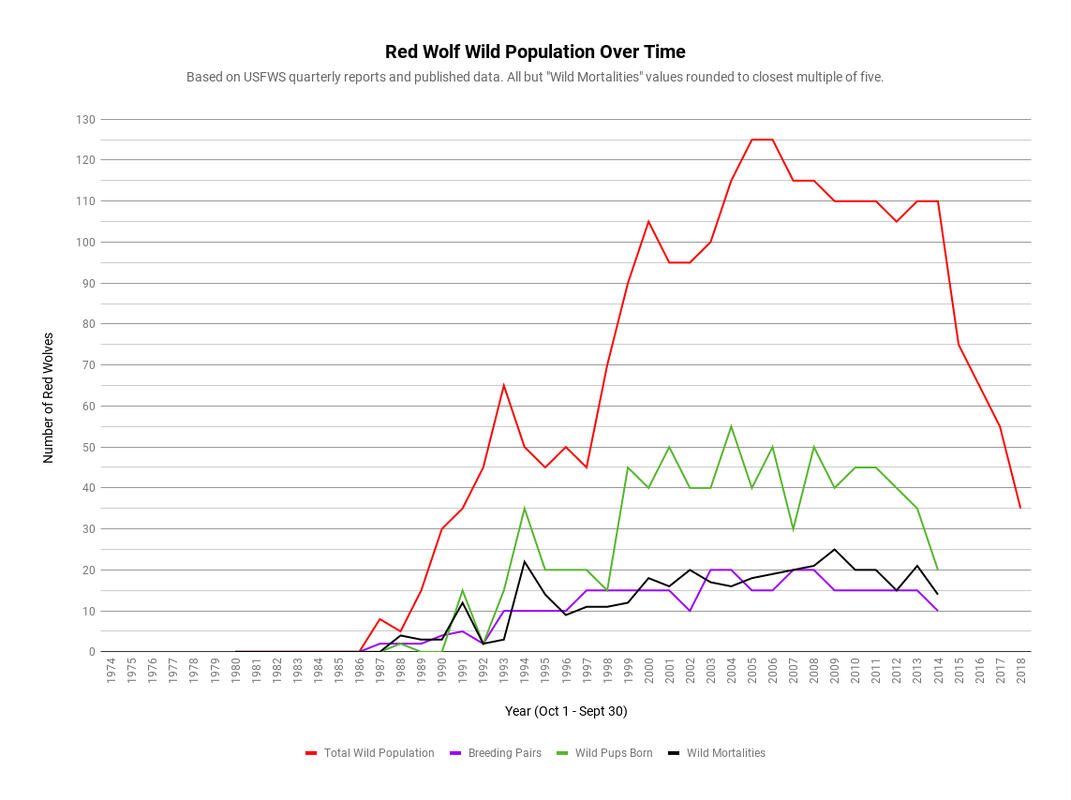
The red wolf was declared biologically extinct in the wild in 1980. Once reintroduction efforts began in 1986, the wild red wolf population rose relatively steadily to roughly 65 by the year 1993 before falling to a slight plateau of around 47 wolves between 1994 and 1997. From 1998 to 2006, the population again rose steadily towards the current target wild red wolf population of roughly 220, reaching approximately 125 wolves between 2005 and 2006. The wild population then dropped to a plateau around 110 wolves until 2014 before falling drastically to a current total of no more than 35 wolves today. This drastic fall corresponds almost exactly with a five-year review of the Red Wolf Recovery Program, at the end of which the United States Fish and Wildlife Service was found to be inadequately managing the wild red wolf population.As would be expected, the number of breeding pairs and wild pups born has reflected the total wild red wolf population. Large spikes in wild red wolf mortalities precede falls in the total wild red wolf population.

This graph plots the total wild, captive, and overall red wolf populations over the periods for which data is available. The curves for the captive and wild populations are the same as in previous graphs. The total red wolf population is calculated from the sum of wild and captive population values for each given where data for both population types was available.While the data for the total red wolf population seems to be rising favorably, upon closer inspection it becomes clear that the decrease in population after 1994 was caused by two consecutive periods of troubling circumstances. Between 1994 and 2005, a relative plateau was caused by stagnation in the captive red wolf population despite growth in the wild population. The relative plateau was continued from 2006 to today by falling wild populations despite growth in the captive-maintained population.
Red Wolf Mortality Statistical Trends
Red wolf mortality data provides an analysis of different causes of red wolf deaths in the wild. Quantitative information reveals how each cause has played a role in wild red wolf population fluctuations over time, as well as which causes are most significant.
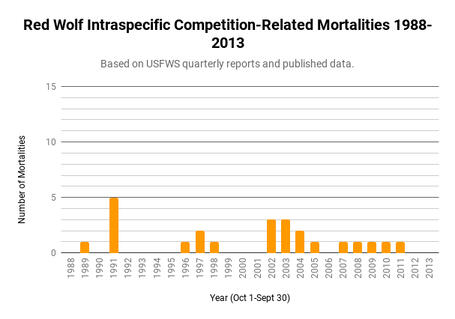
The number of mortalities due to competition and fighting between red wolves has always been low, peaking at only five in 1991. Since then, these deaths have never exceeded three per year.
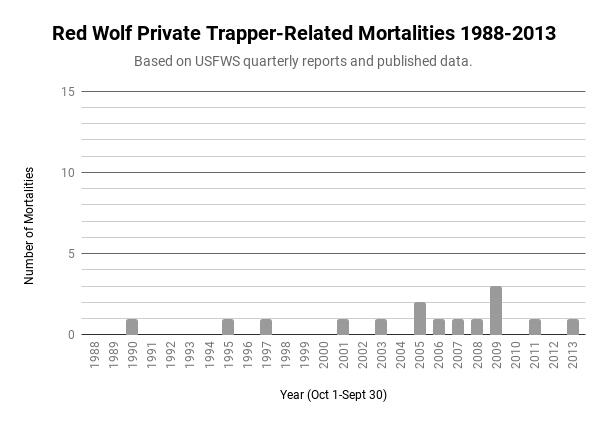
Red wolf mortalities caused by private trapping have remained consistent yet low in number for most the duration of the Red Wolf Recovery Program from its inception to this day.
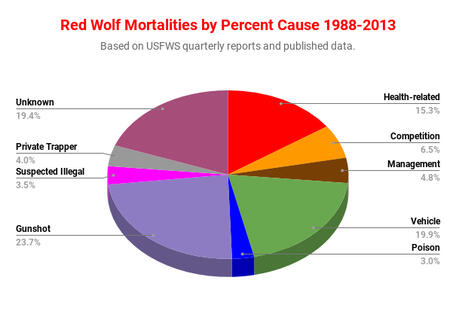
Gunshot, vehicle, and health-related mortalities account for most red wolf deaths, along with mortalities stemming from unknown causes.
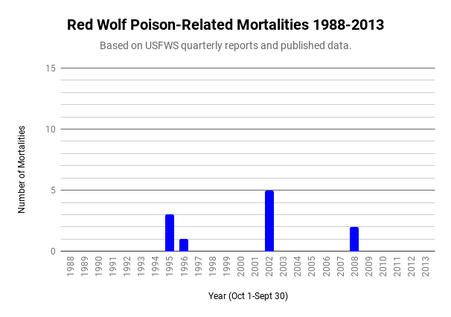
Mortalities due to poisoning are rare, but they have happened, as shown by events in 1995, 1996, 2002, and 2008. These poisons are often not intended for red wolves, but are indiscriminate.
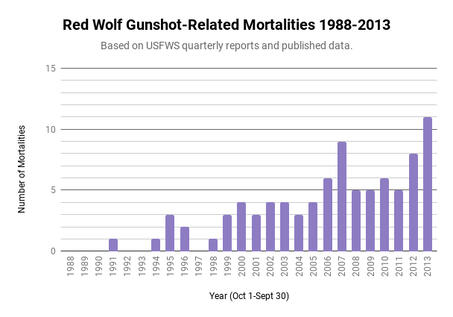
Gunshot mortalities have long been a significant cause of concern, as red wolves are frequently mistaken for coyotes and blamed for attacking livestock. These incidents have increased over time.
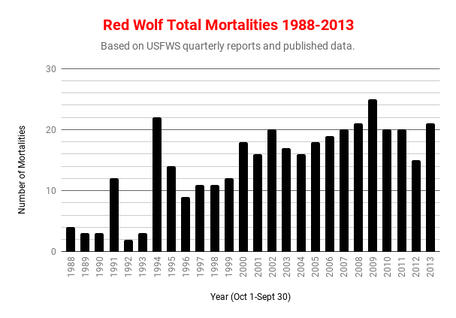
The number of red wolf mortalities in the wild has reflected red wolf wild population growth since 1992 (see population section).
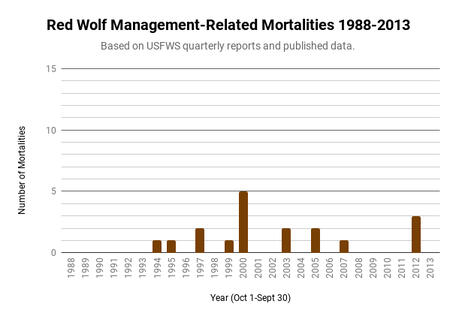
Management-related mortalities primarily involve animals that are euthanized due to incurable dieseases and untreatable injuries. These types of mortalities have never exceeded five a year.
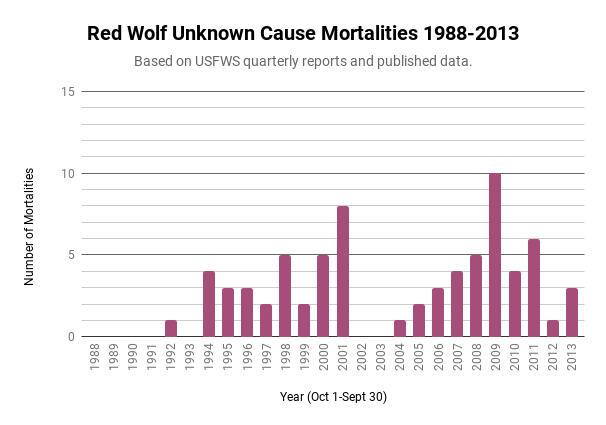
Red wolf deaths due to unknown causes make up a significant portion of red wolf mortality data. Due to many difficulties tracking red wolves, not all deaths can be attributed to specific causes.
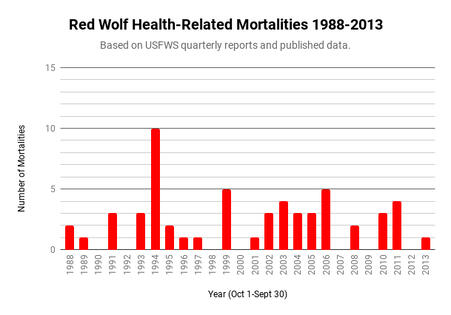
Health-related mortalities refer to red wolf deaths due to disease or bodily malfunction. These mortalities have remained relatively stable, aside from a peak in 1994.
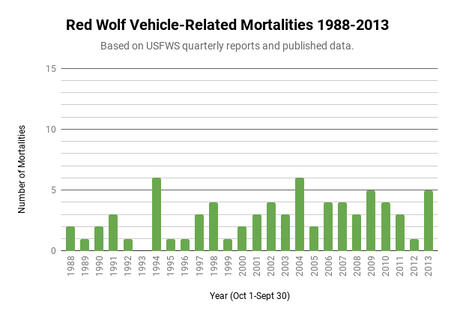
Mortalities due to vehicle impacts have been a consistent cause of red wolf population losses since the establishment of a wild red wolf population under the Red Wolf Recovery Program.
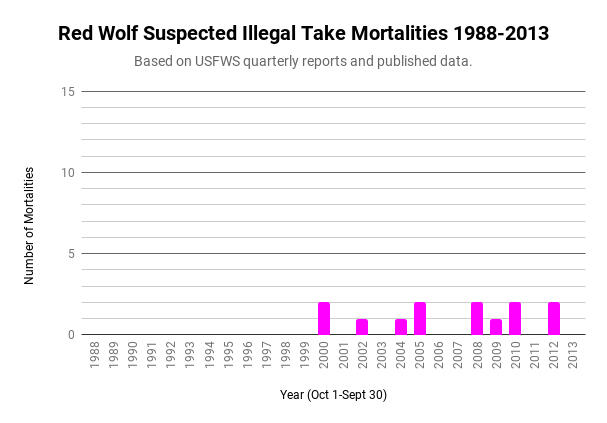
Although they are relatively infrequent, suspected intentional and illegal red wolf killings have been a cause of concern for many years due to controversies and disputes surrounding recovery.
Red Wolf Releases
Red wolf release data focuses on the number of releases of captive red wolves into the wild.

The number of releases of captive red wolves into the wild peaked in both 1990 and 2000 at around 13 wolves. Since 2015, no red wolves have been released into the wild as a result of a red wolf recovery status review conducted by the United States Fish and Wildlife Service, as well as other delays and disputes.
Red Wolf Recovery Program Finances
Red Wolf Recovery Program finance records offer insight into how much funding the red wolf recovery program needs each year to sustain its efforts.
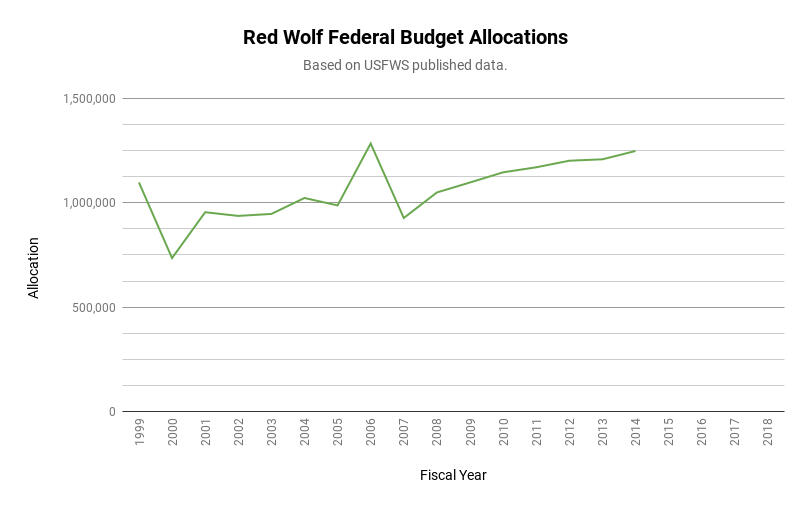
From what data is available for the years 1999-2015, federal government funding for the Red Wolf Recovery Program has remained fairly constant at around one million dollars a year.
White-Tailed Deer Population
White-tailed deer data provides a backdrop for red wolf data by providing comparable population data that is influenced by similar factors, such as vehicular incidents.
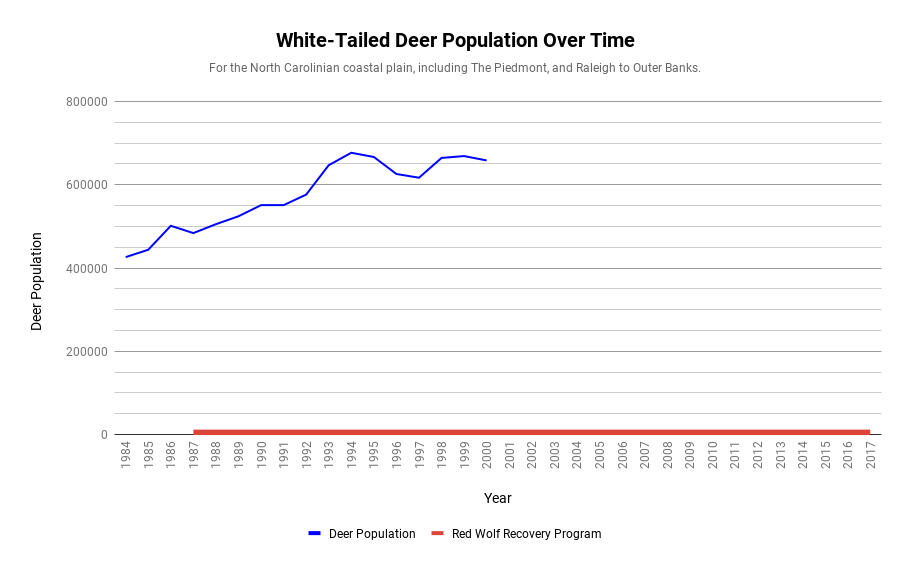
The white-tailed deer population of the areas that include the red recovery area steadily rose from 1984 to 2000, even despite the introduction of red wolves to the same range beginning in 1987. Data for the years 2001-present has not yet been found, but Red Wolf Review is actively looking. If you can help fill in missing data, please let us know by leaving a comment here.
Vehicle-Animal Crashes by County
According to this data from the North Carolina Department of Transportation, vehicular crashes caused by wildlife (namely white-tailed deer) have remained rather constant in the five counties that make up the red wolf recovery area. This data is useful because it can be compared to the number of red wolf vehicular mortalities, as well as any changes in deer population overall.
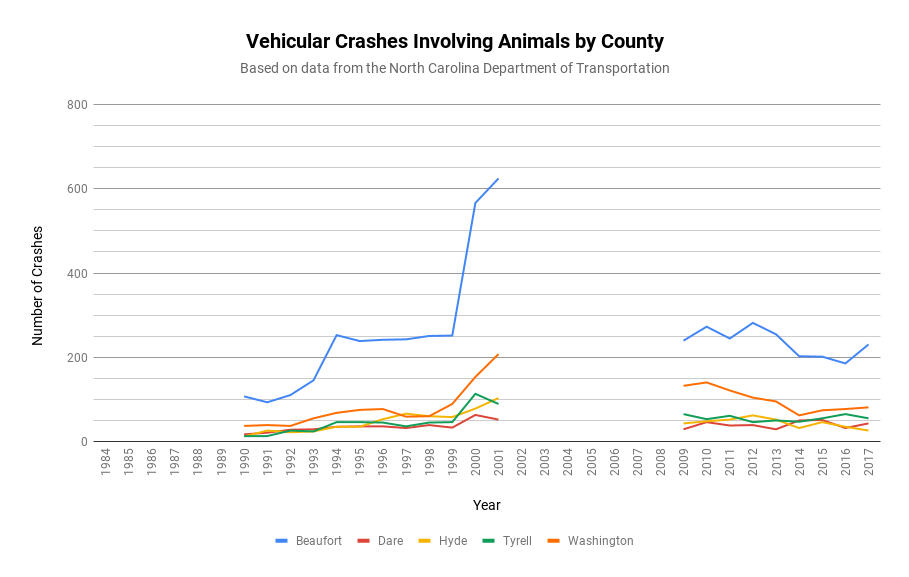
Please note that the above NCDOT data for the years 2000 and 2001 is not definite and is only included as a placeholder. A detailed explanation can be found via the bold link below. If you can help us fill in missing and uncertain data for the years 2000-2008, please let us know by leaving a comment here.
How can you help red wolves?
Critically endangered red wolves need the help of wolf advocates more than ever nowadays. With trouble coming from government noncooperation, public misunderstandings, and saboteurs who wish to undermine programs that are in place to help them, it is extremely important that as many people as possible do their part to help Canis rufus.If you wish to help the red wolf cause, there are a number of things you can do. This guide gives examples, sources, and other important information on how you can support the red wolf cause in the most efficient and constructive ways possible. Wolf activism isn't an easy task, but it is an extremely rewarding in that you get to help creatures who would likely be doomed to extinction without the action of those who care.
Did you know:ANYONE can help red wolves, as long as they truly have a desire to learn and share what they know.
Wolf activism requires advocates to have three critical attributes:A Positive Attitude: Many times you will run into situations that are very sad, or mentally exhausting, such as when you see an animal in distress or learn that an unfavorable law has passed. In these tough times it is critical that you keep a positive attitude about things, because doubt and fear can quickly lower your productivity. If a person perseveres through the problem at hand, they will soon find that they can achieve much more for wolves than they thought!Ingenuity: An ability to think outside the box is an extremely important part of wolf activism. Without creative solutions to conservation and public relations problems, programs such as the Red Wolf Recovery Program may not have been as successful as they have been. It takes imagination to help red wolves and other canids, as keeping on with the status quo rarely ever gets the important things done.Passion: Perhaps the most important attribute of a wolf advocate is their passion for what they do. Passion is what keeps people fighting despite all odds, it is what shows the opposition that wolf advocates mean business, and it is what keeps people going despite the occasional loss or misfortune. Without the enthusiasm of advocates, researchers, and biologists, many of the successes of the red wolf past may never have come to be.
From the late 1960's to more recent years, red wolf recovery efforts have been gradually increasing. For the program to continue to operate successfully, it is important that there are many people who are knowledgeable about red wolves to stand behind it. To gain this important knowledge, browse through some of the most recommended sources of information, such as those listed below.Some good sources of information include:- T. Delene Beeland's nonfiction book, The Secret World of Red Wolves, gives numerous first-hand excerpts from various parts of red wolf conservation. If you wish to get a closer look at what the world around these critically endangered canids is like, as well as learn a little about the people who work to keep their population stable, this is a highly recommendable source.
- The Red Wolf Coalition's website is a metaphorical gold mine of information regarding all aspects of red wolves, red wolf conservation, and much more. Here you can find facts about the history, biology, behaviors, and more of Canis rufus, and find multiple ways to help the cause through the RWC.
- The U.S. Fish and Wildlife Service's website, specifically the portion relating to red wolves, gives important background information about the species as well as up-to-date info on the current state of the canid population. You can monitor the status of red wolf conservation by keeping an eye on this website.
Exploring the information sources listed in the previous step can eventually lead a person to know a lot about red wolves and red wolf restoration. Still, it is important to remember that there will always be people who care about red wolves but do not know much about them, and others who are oblivious to the plight of the red wolf in the first place. Thus, it is important to share as much information with others as possible to ensure that there is a large, knowledgeable base of supportive red wolf advocates who are willing to work for positive change.To educate others about red wolves:- Start conversations about red wolves with friends and others who care about the environment, and mention a few true facts and statistics if you can.
- Share the information sources listed in the previous step with others. Doing so will allow them to learn at their own pace and convenience, thus making them feel enthusiastic rather than rushed.
- Discuss the material in each source with other people in a relaxed setting. This allows people to ask questions and share their own ideas and opinions without feeling like they are being quizzed or judged for any errors in their knowledge.
- Don't be afraid to ask questions. If you or another person are unsure about something related to red wolves that is not explained in any of the previous sources, contact the Red Wolf Coalition or one of the Red Wolf Species Survival Plan participant locations. They will be glad to help you understand more about red wolves.
By spreading the word about red wolves, you will inevitably run into or create other red wolf advocates. This is a fantastic opportunity to work together to have a greater impact on the red wolf situation. While working alone can get things done, working together ensures that red wolf advocates have a louder voice in red wolf recovery. Teamwork also ensures that the sometimes stressful workload of fighting for red wolves is shared, and that if there is a problem, more people can contribute to a viable solution. You can find many red wolf advocates on the Red Wolf Coalition's Facebook page.
Promoting and supporting positive changes for red wolves and red wolf recovery is the most important part of red wolf advocacy. Without the voice of the people, the program has very little to stand on. To help promote red wolf conservation, there are a number of things you can do.How to promote red wolves:- Leave polite, yet assertive (not aggressive) comments on government social media pages showing support for red wolf conservation.
- If you can, help out with any of the causes the Red Wolf Coalition announces on it's social media pages.
- Sign legitimate petitions supporting red wolf restoration. There are plenty of fake petitions out there, so fact checking is always a must in order to verify legitimacy.
- Write a letter, leave a phone message, or send an email to those who work for either the U.S. Fish and Wildlife Service or the North Carolina Wildlife Resources Commission, which are the organizations that oversee red wolf recovery efforts. All messages should clearly exhibit support for red wolf recovery.
Often in the course of being a red wolf advocate, one comes across people (or groups of people) who oppose red wolf restoration. Many times these encounters result in heated arguments with insults and other unpleasant language being thrown back and forth. Such phenomenon is not helpful in the least to the red wolf situation, and only serves to make wolf advocates seem like angry, intolerant people (even if they didn't start the conflict in the first place).To avoid making the problem worse while trying to fix it, try following these steps:- Pause, and take a deep breath. The world isn't going to end if you simply walk away from a debate. The person on the other end does not singlehandedly control the red wolf's fate, so there is no need for you to waste your time or energy on them.
- Be the bigger person and remain civil and polite throughout the conversation. The other person may be slinging profanity and threats at you, but ignoring their ignorance simply accentuates their foolishness. Don't sink to their level.
- Use facts and statistics to back up your argument. No one can argue with science, and if they do, they will look like a fool.
- If things get too heated, report them or tell the authorities. Threats and harassment should be handled by those who's job it is to deal with these situations. Do not take the rules into your own hands.
- Avoid these types of conflicts if possible.
Step Seven:
Special thanks to the Red Wolf Coalition for the creation of many of the resources listed on this page. Other resources found via the International Wolf Center and the United States Fish and Wildlife Service.
There are numerous nonprofit and other organizations working to help red wolves. Such organizations help fund important parts of the recovery effort, spread news and information about red wolves, and generally promote the restoration of Canis rufus on the whole. Such tasks are not done easily, or for free, and as a result these organizations must ask for donations from the public to continue their efforts. For those who wish to donate to help red wolf organizations, notable potential donation recipients are listed below in order of importance:- The Red Wolf Coalition
- Red Wolf Species Survival Plan participants
Step Eight: Stay up to Date
Special thanks to the Red Wolf Coalition for the creation of many of the resources listed on this page. Other resources found via the International Wolf Center and the United States Fish and Wildlife Service.
There are always important and often urgent developments in the world of red wolf conservation. It is critical that advocates follow these alerts closely to avoid missing opportunities, or making errors in judgement. To stay up to speed on red wolf restoration, there are a number of reliable and legitimate news sources and feeds that you can check. Some of the best are listed here.Sources of news:- The Red Wolf Coalition's Facebook page.
- The US Fish and Wildlife Service's Red Wolf Recovery Program website and social media.
Step Nine: Brainstorm Solutions
Special thanks to the Red Wolf Coalition for the creation of many of the resources listed on this page. Other resources found via the International Wolf Center and the United States Fish and Wildlife Service.
There is a definite need for creativity in the realm of red wolf advocacy, as there are a number of important problems that need "outside-the-box" solutions. If you can think of a feasible solution to any of the following problems, please let those with connections, such as those at the Red Wolf Coalition, know!- Conservation is a tough task, often requiring biologists to traverse tough terrain and dense underbrush. If there were an efficient and cost-effective way to easily traverse these areas without harming or disturbing the environment, it would make conservation efforts much, much easier for those directly in contact with red wolves.
- Red wolves are tracked with radio VHF (Very-High-Frequency) collars or (occasionally) GPS (Global Positioning System) collars. While these collars allow for noninvasive studies of red wolf behavior, they also have issues with staying on for as long as possible, as they run on batteries which eventually drain. If there were a sustainable, economic solution to this problem, it would make tracking much safer for wolves and biologists.
- In order to be given vaccines and medical/research treatment, red wolves are often trapped with humane leg hold traps, which are much safer than traps used for hunting. These traps are not perfect, however, and a wolf caught in a leg hold may still manage to hurt itself. If there were an alternative to leg hold traps that could ensure even more safety of wolves while not costing lots of money, it would help research efforts greatly.
- Local residents of the red wolf recovery effort may have significantly different views about red wolf recovery. Some support the effort, some remain neutral, and still others are firmly against it. As the people who are the most directly affected by recovery efforts, they of course deserve the most say. However it is important that there is a compromise between recovery and fairness to the local population in the red wolf situation. More information can be found in chapter seven of T. Delene Beeland's book The Secret World of Red Wolves.
Step Ten: Never Give Up!
Special thanks to the Red Wolf Coalition for the creation of many of the resources listed on this page. Other resources found via the International Wolf Center and the United States Fish and Wildlife Service.
If you follow the steps listed in this guide, you will be well on your way to making a positive difference for red wolves! The going will get tough, and in many cases, it already is, but with enough perseverance and creativity, there is nothing that wolf advocates cannot accomplish. There is a lot of work to do, but we can do it!Thank you for reading this guide!
The written portion of the guide on this page is © 2017-2024 Red Wolf Review. All Rights Reserved.
Teaching Tools
One of the main activities that can help red wolf recovery efforts is the spread of red wolf knowledge through education. While informal learning in public settings is beneficial, a great impact on public perception of red wolves can also be made in the classroom. The resources listed on this page can be used in schools to teach students of various ages and learning abilities to understand red wolves. They can also be used in informal settings if necessary.Want to test your knowledge? Try this quiz!
Special thanks to the Red Wolf Coalition for the creation of many of the resources listed on this page. Other resources found via the International Wolf Center and the United States Fish and Wildlife Service.
Grades K-6
Teaching resources useful to younger children.- The Great Wolf Rescue
- Far Traveler (See below)
Grades 7-12
Teaching resources useful for adolescents.- Red Wolf Coalition: General wolf facts
- AnimalDiversity.Org Red Wolf Facts
- Far Traveler (See below)
Post-Secondary and Adult
Teaching resources useful for those in university and beyond.Red Wolf Coalition research library
Far Traveler: A Teacher’s Companion to Red Wolf Recovery
The United States Fish and Wildlife Service makes a valuable teaching resource available to the public in the form of its Far Traveler curriculum guide. Written by some of the most respectable people in the red wolf conservation effort (some of whom also helped in the creation of Red Wolf Review), this resource is a great help in any classroom setting. Far Traveler is useful for audiences of various ages, learning abilities, and grade levels, and it offers an engaging and intriguing learning experience for all.Find a printable copy of Far Traveler via the Red Wolf Coalition here. More information about Far Traveler can be found within the document itself.Image credit: Front cover of Far Traveler Document, United States Fish and Wildlife Service.
Written Educational Sources
Original lists compiled by the United States Fish and Wildlife Service and International Wolf Center.
Periodicals:- Southeastern Naturalist – Volume 1, Number 2, 2002, “The Original Status of Wolves in Eastern North America” by Robert M. Nowak.
- International Wolf Magazine, Winter 2007 – Special Red Wolf Issue – Published by the International Wolf Center
Younger Readers:- Journey of the Red Wolf by Roland Smith, Dutton Juvenile, 1996
- Red Wolf Country by Jonathon London, Dutton Children’s Books, 1996
- Red Wolves – And Then There Were (Almost) None by Meish Goldish, Bearport Publishing, 2009
- The Red Wolf by Fred Harrington, The Library of Wolves and Wild Dogs, PowerKids Press, 2002
Upper Middle School to Adult:- Return of the Wolf – Successes and Threats in the US and Canada by Steve Grooms, 3rd edition, Nova Vista Publishing Company, 2005
- The Red Wolf – Help Save This Endangered Species by Alison Imbriaco, Enslow Publishers, Inc., 2008
- Wolves: Behavior, Ecology, and Conservation, edited by L. David Mech and Luigi Boitani, Chapter 11 – “Restoration of the Red Wolf” by Michael K. Phillips, V. Gary Henry and Brian T. Kelly, The University of Chicago Press, 2003
- Meant To Be Wild – The Struggle to Save Endangered Species Through Captive Breeding by Jan DeBlieu, Chapter 1, “The Wolves of Alligator River,” Fulcrum Printing, 1993
- Hoagland on Nature by Edward Hoagland, Essay Collection, “Lament the Red Wolf,” pgs. 87-130, The Lyons Press, 2003
- Another Country – Journeying Toward the Cherokee Mountains by Christopher Camuto, Henry Holt, 1997
- The Red Wolf by Alvin Silverstein, Virginia Silverstein and Robert Silverstein; the Millbrook Press,1994
- Gray Wolf, Red Wolf by Dorothy Hinshaw Patent, Sandpiper Publisher, 1994
Research Tools
Learning about red wolves can be a bit of a daunting task due to the sheer amount of information there is to find and digest. In order to help solve this problem we have compiled a list of useful starting points for deeper research into red wolf related issues. When used in conjunction with this website, these sources can provide a detailed look into almost all of the important issues regarding red wolves and animal conservation. Furthermore, all of these sources can be identified as academic sources, so they will likely be usable on most research papers and reports.Please note that many of the sources listed below will probably be difficult for children to understand and may be intended for mature audiences. If you are looking for youth-appropriate sources, check out the teaching tools section.
Red Wolf Info Sites
Learn more about red wolves and their general situation.
- The Red Wolf Coalition - Current red wolf news and useful documents.
- The USFWS red wolf website - Red Wolf Recovery Plan information
- Wikipedia red wolf article - It is best to fact check information here.
Conservation Info Sites
Find out more about red wolf management and its leading organizations.
- Association of Zoos and Aquariums - Organization that oversees the RWSSP
- Point Defiance Zoo and Aquarium - The first participant facility in the RWSSP
- Defenders of Wildlife - Info on conservation for many animals
Useful Online Tools
Teaching resources useful for those in university and beyond.Red Wolf Coalition research library
- ProCon.org - Coverage of all sides of major controversies
- Statista.com - Verifiable statistics on many topics
- Wolfram Alpha - Find comprehensive info on almost anything
Novels and Light Reads
Learn more about red wolves through easier, chapter-based reads.
- The Secret World of Red Wolves - by T. Delene Beeland
- Another Country - by Christopher Camuto
Textbooks and Reference
Learn more about red wolves through textbooks with an academia-style format.
- Wolves: Behavior, Ecology, and Conservation - Edited by L. David Mech and Luigi Boitani
- Far Traveler: A Teacher's Companion to Red Wolf Recovery - by the USFWS
Academic Literature
Academic literature such as peer-reviewed journal articles and scientific papers. Library compiled by the Red Wolf Coalition.
Novels and Light Reads
Library Databases
Many libraries have online databases listing titles and related information on all of the content they store in their collections. These databases can prove invaluable to anyone searching for a book on a particular subject or with a certain keyword or phrase included. Aside from databases for specific libraries, there are also numerous larger databases that store information on content availability in numerous libraries across long distances. These larger databases can be used to plan requests for interlibrary loans (see below). These databases can also provide useful information for citations in papers, as well as links to similar works on related topics. Visit your local or school library website to see their catalog or database.
Interlibrary Loans
An interlibrary loan can be made when a person requests a book from one library to be sent to another library on loan. This allows people to gain access to books that may otherwise only be available in distant places. Most libraries have their own information on applying for an interlibrary loan, and there are loan programs spanning districts, universities, states, countries, and even the world. Things requested via an interlibrary loan can often be picked up at a local library and returned to any other library, making for a convenient and extremely useful system. The transfer time on most interlibrary loans is often no more than a week. For more information, see this general description or ask a librarian at your school or local library.
Library of Congress
Located in Washington D.C., the United States Library of Congress is the largest library on earth, offering almost twenty million resources to the public for research and information purposes. Consisting of a collection of books, historic documents, records, and much more, the Library of Congress is an excellent place to search after first looking at local libraries and online. The Library of Congress also offers its own interlibrary loan program (see previous), allowing certain items to be withdrawn anywhere in the country for free for up to two months (internationally there is a small fee). You can explore the official Library of Congress website here, or go directly to their collection catalog landing page here.
Freedom of Information Act
The Freedom of Information Act is a law passed in the United States in 1967 that allows public access to past US federal government agency records, with the exception of state and local government, personal, and security related documents. The law primarily applies to records from government agencies (such as, for example, the United States Fish and Wildlife Service which falls under the Department of the Interior). Information can be requested via the Freedom of Information Act by private citizens, and there is a different request method and point of contact for each individual agency. More information about submitting a request under the Freedom of Information Act can be found on the FOIA website.
Google Scholar
Google Scholar can help you find journal articles and academic papers quickly for any topic you search for. It can also help find citations, patents, and date-sensitive information. Search results can be bookmarked and saved to your Google account. Click here to visit Google Scholar.
Terms of Service and Privacy Policy
(By using this website you agree to and aknowledge the following)
SECTION A
REGARDING THE USE OF THIS WEBSITE AND ANY CONTENT CONTAINED THEREIN:
- All written informational content on the Red Wolf Review website is free to use and distribute as necessary, with the exception of any plagiarism of the aformentioned website or its sources. This free-use policy does NOT include images, videos, or downloadable files unless clearly marked otherwise.
- Images, videos, and downloadable files may be linked to by anyone for non-commercial and legal purposes. Photos may not be downloaded unless clearly marked as sharable or in the public domain.
- Red Wolf Review assures that all information on this website is sourced from the most credible sources available and attributed as clearly and honestly as possible.
- Content that is the intellectual property of another entity besides Red Wolf Review is marked clearly, and either sourced from the public domain or used with permission or under license.
- You may use all information on this website at your own risk. Red Wolf Review and its affiliates will take no responsibility and give no indemnity for problems caused by third party misuse of the information on this website.
SECTION B
REGARDING RED WOLF REVIEW ONLINE COMMUNITIES:
- All visitors to Red Wolf Review websites and social media pages must treat each other with respect and cordiality at all times. The fostering of real-life hostility, disrespect, or malice will not be tolerated by any means.
- Absolutely no "flaming," "trolling," "spamming," "hacking," "phishing," fraud, or other activities deemed inappropriate and unsuitable for an online community environment are allowed on this website or any online page related to Red Wolf Review.
- Red Wolf Review harshly discourages profanity, suggestive content, or otherwise inappropriate behavior at any of its events or on any of its online pages, including this website.
- Red Wolf Review reserves the right to block, ban, and/or report anyone who violates these rules.
SECTION C
REGARDING LAWS, LIABILITY, AND GOVERNMENT REGULATIONS:
- All visitors are responsible for their own behaviors and actions. Red Wolf Review and its affiliates will not and cannot be held responsible for any inappropriate or destructive behaviors resulting from the independent decisions of individuals regarding the information on this website or any of its other online presences.
- Red Wolf Review and its affiliates will not and cannot be held responsible for any inconvenience, trouble, hardship, or legal, monetary, or other problems resulting from any third party irresponsible use of any information on this website or anywhere else. Responsibility for these things falls to the individual(s) who caused the problem in the first place.
- Red Wolf Review is also not responsible in any way for any and all visitor actions outside of its online pages or this website.
All visitors to Red Wolf Review are required to respect the intellectual property rights of all other content creators both online and offline.
- Visitors and members must adhere to and respect all applicable laws in their respective country, region, and locale. The violation of any legal statutes will not be tolerated whatsoever.
- Red Wolf Review and its affiliates are not related, endorsed by, affiliated, or connected to any entities not explicitly stated on its website. Red Wolf Review is not a government organization or a for-profit organization. It is self-funded, run, and organized by private individual(s).
- All organizations listed on the "Important Organizations" page of this website are unaffiliated with Red Wolf Review, although the Red Wolf Coalition has assisted in the curation and promotion of some early content on this website and Red Wolf Review social media pages.
SECTION D
REGARDING RED WOLF REVIEW AS AN ORGANIZED ENTITY:
- Red Wolf Review are an informational/research website dedicated to public education about red wolves.
- Red Wolf Review is not a business or profit venture in any sense. It does not earn or seek to earn any monetary reward by offering information that is publicly available to use in the first place. Red Wolf Review compiles the information; it does not sell the information.
- Red Wolf Review does not participate in, endorse, or promote movements of social unrest, civil disobedience, or illegal activity. It is not a tool for anyone's political or social agenda. Red Wolf Review's single and primary goal is to promote education and awareness about red wolves.
SECTION E
REGARDING RED WOLF REVIEW'S RIGHTS:
- Red Wolf Review, its affiliates, and its administration reserve the right to bar anyone from using this website and/or its other online presences if any of the terms, rules, or standards listed in these terms of service are broken.
- If the above rules and regulations are broken, in appropriate situations, Red Wolf Review reserves the right to notify the correct authorities, including police, if necessary.
- Red Wolf Review reserves the right to change, modify, add to, or subtract from these terms at any time with or without notice.
- Red Wolf Review reserves the right to retract the benefits of the Red Wolf Review website and its related social media at any time, for any justifiable reason, temporarily or permanently, and with no prediction of the duration of the retraction.
- Administration has final word on all policies.
SECTION F
REGARDING PRIVACY:
- Red Wolf Review will never collect personal information about visitors unless it is voluntarily given, such as through our quizzes, polls, or surveys.
- Red Wolf Review will never share visitor information unless required by law to do so. Exceptions include anonymized responses given on our surveys and quizzes. Please check with the websites that host these surveys or quizzes for more information about how you can control what information is shared.
- While Red Wolf Review takes great measures to ensure your privacy and safety, please be aware that Red Wolf Review, its affiliates, and its administration will not and cannot be held responsible or liable for any breaches in security; personal, or public that are out of its control. You, as a user and/or visitor, are also responsible for keeping your own information safe.
- If you notice any suspicious, dangerous, or illegal activity on our website or online pages, please let us know immediately.
- You can be sure that a Red Wolf Review online presence is legitimate if it is linked directly on this official website.
These terms of service are the intellectual property (©) of Red Wolf Review 2016-2024. All Rights Reserved.

